
- ��Ӱֱ��
- Travel Packages
- Top Destination
-
Travel Attraction
By Category
Top Attraction

- Travel Agents
- Car Rentals
- Hotels
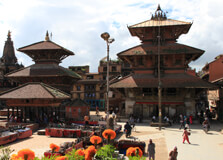
Kathmandu Durbar Square, also known as Hanuman Dhoka Durbar Square, is one of the most historically and culturally significant landmarks in Nepal. Located in the heart of Kathmandu, this ancient royal square was once the residence of Nepalese royalty and is now a UNESCO World Heritage Site. The square is surrounded by spectacular architecture, intricate wood carvings, and centuries-old temples that showcase the artistic and cultural achievements of the Malla kings who ruled the Kathmandu Valley. The square is a popular tourist destination and an important religious and cultural site for locals. It is a place where history, art, and spirituality blend beautifully, offering a glimpse into the rich heritage of the Kathmandu Valley. How to Reach Kathmandu Durbar Square, Kathmandu Kathmandu Durbar Square is conveniently located in the central part of the city, making it easily accessible by various modes of transportation. If you are staying in the Thamel area, which is a major tourist hub, the square is about a 15-20 minute walk away. Taxis, rickshaws, and ride-sharing services like Pathao or Tootle are readily available throughout Kathmandu and provide a convenient way to reach the square. For budget travelers, local buses and micro-vans also connect different parts of the city to Ratna Park, which is a short walk from Durbar Square. Walking is a great way to explore the surrounding areas and experience local street life before entering the historic square. Weather Kathmandu experiences a moderate climate throughout the year. The best time to visit Kathmandu Durbar Square is during spring (March to May) and autumn (September to November), when the skies are clear, the weather is pleasant, and the air quality is better. These seasons offer perfect conditions for walking around the square and taking photographs. Summers (June to August) can be warm and humid, and the monsoon season may bring frequent rain showers, which can make the stone-paved square slippery. Winters (December to February) are relatively cold, with temperatures sometimes dropping below 5°C in the mornings and evenings, though the days are often sunny and comfortable for sightseeing. Timing Kathmandu Durbar Square is open to visitors every day. The general visiting hours are from 9:00 AM to 5:00 PM, which includes access to the museums and palaces within the square. However, the outer area of the square with the temples and public courtyards remains open throughout the day, and you can walk around and take photos even outside of official hours. It is best to visit in the morning or late afternoon to avoid the midday heat and to enjoy a more peaceful atmosphere before or after the crowds arrive. Why Famous for Kathmandu Durbar Square, Kathmandu? Kathmandu Durbar Square is famous for its stunning medieval architecture, historical significance, and spiritual importance. It served as the royal palace for the Malla kings and later the Shah kings until the 19th century. The square is known for its richly decorated temples, courtyards, and palaces, all built in traditional Newari style. The square is also known for being home to the Kumari Ghar, the residence of the Living Goddess Kumari, who is revered by both Hindus and Buddhists. Witnessing the appearance of the Kumari at her window is considered a blessing and is one of the most unique cultural experiences in Nepal. Entry and Visit Details about Kathmandu Durbar Square, Kathmandu There is an entry fee for foreigners to access Kathmandu Durbar Square, which goes towards the maintenance and preservation of this heritage site. As of now, the entry fee is approximately NPR 1,000 for foreign nationals. SAARC nationals pay a reduced fee of about NPR 150. Nepali citizens can enter free of charge. Tickets can be purchased at the main entrance gates. It’s recommended to keep your ticket handy in case you are asked for it by security personnel inside the square. Guided tours are available for a more in-depth understanding of the historical and cultural aspects of the area. History and Architecture Kathmandu Durbar Square dates back to the 3rd century, with the majority of the current buildings constructed between the 12th and 18th centuries by the Malla kings. The name "Durbar" means palace, and this square served as the royal palace complex for hundreds of years. The architecture is predominantly in the Newar style, featuring multi-tiered pagoda roofs, intricate wooden windows, and beautifully carved doorways. Notable buildings include the Hanuman Dhoka Palace, named after the monkey god Hanuman, whose statue guards the entrance; Taleju Temple, dedicated to the goddess Taleju; and the nine-story Basantapur Tower. Despite being damaged during the 2015 earthquake, many of the buildings have been carefully restored or are undergoing reconstruction. Restoration efforts continue to preserve the cultural and architectural legacy of this important site. Things to Do at Kathmandu Durbar Square, Kathmandu There is much to see and do at Kathmandu Durbar Square. Here are some highlights: Visit the Hanuman Dhoka Palace Museum: Explore the former royal palace and learn about the history of the kings who ruled the Kathmandu Valley. See the Living Goddess: If you're lucky, you might catch a glimpse of the Kumari at Kumari Ghar, especially during festivals. Admire the Architecture: Take time to appreciate the fine details in the carvings, windows, and temple structures. Attend a Festival: The square is the center of many major festivals like Indra Jatra and Dashain, which feature processions, dances, and traditional rituals. People-Watch and Relax: Sit on the temple steps and observe the daily life of Kathmandu unfold around you. Photography: The mix of ancient architecture, local life, and ceremonial events provides endless photo opportunities. Facts and Tips about Kathmandu Durbar Square, Kathmandu It is one of the three Durbar Squares in the Kathmandu Valley – the others are in Patan and Bhaktapur. UNESCO designated it a World Heritage Site in 1979. Many temples in the square are dedicated to both Hindu and Buddhist deities. Early morning or late afternoon visits are ideal for good lighting and fewer crowds. Wear comfortable shoes as the square is paved with stones and involves walking. Respect local customs, especially around religious sites—removing shoes before entering temples is expected. Hiring a guide can enhance your experience by explaining the deep history behind each building and temple. Conclusion Kathmandu Durbar Square is more than just a collection of old buildings—it is a living piece of history that reflects the art, culture, and spirituality of Nepal. Visiting the square allows travelers to step back in time and experience the grandeur of the Malla dynasty, the vibrancy of local traditions, and the architectural brilliance of Newari craftsmanship. Whether you're a history lover, an architecture enthusiast, or a curious traveler, Kathmandu Durbar Square offers an unforgettable cultural experience in the heart of Nepal’s capital.
Explore More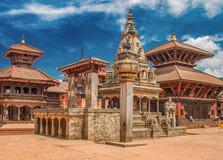
Patan Durbar Square, located in the heart of Lalitpur city (just south of Kathmandu), is one of the three Durbar Squares in the Kathmandu Valley. It is a UNESCO World Heritage Site and is renowned for its stunning Newari architecture, rich cultural heritage, and historical significance. The square was once the royal palace of the Malla kings who ruled over the Patan Kingdom and remains a beautiful showcase of traditional Nepali craftsmanship. With its temples, courtyards, and palaces, Patan Durbar Square is a must-visit destination for anyone interested in Nepal’s history, art, and culture. How to Reach Patan Durbar Square, Kathmandu Patan Durbar Square is located in Lalitpur, about 5 kilometers south of central Kathmandu. It is easily accessible by various modes of transport. Taxis are widely available and are the most convenient way to reach the square, especially for visitors unfamiliar with the city. The ride from Thamel (a major tourist area) to Patan takes about 20-30 minutes, depending on traffic. Public buses and micro-vans also operate between Kathmandu and Patan. These usually depart from Ratna Park or New Road. The Lagankhel bus stop is the closest to the square, about a 10-minute walk away. For a more immersive experience, some visitors choose to rent bicycles or walk from nearby areas while exploring local neighborhoods. Weather The weather in Patan is similar to that of Kathmandu. The best times to visit are in the spring (March to May) and autumn (September to November), when temperatures are mild, and the skies are mostly clear. During these months, the square is especially beautiful, and visibility is good for sightseeing and photography. Summer (June to August) brings monsoon rains, which may cause the square’s stone pavements to become slippery. However, the rain also adds a lush charm to the surrounding environment. Winters (December to February) are chilly in the mornings and evenings, but generally dry and clear during the day, making it another good time for a visit. Timing Patan Durbar Square is open to visitors every day. The general area is open from early morning to late evening, while the museums and palace complex operate from around 10:00 AM to 5:00 PM. The last ticket is usually sold around 4:00 PM. Some temples and shrines are open throughout the day for worshippers and visitors alike. To make the most of your visit, it is advisable to go early in the morning or late in the afternoon when the light is better for photos and the square is less crowded. Why Famous for Patan Durbar Square, Kathmandu? Patan Durbar Square is famous for its exquisite Newar architecture and its concentration of temples, shrines, and historic buildings in a small area. It reflects the artistic glory of the Malla period, especially from the 16th to 18th centuries. The square is a living museum where religion, art, and daily life come together. One of its most iconic attractions is the Krishna Mandir, a temple built entirely of stone, which showcases a unique blend of Hindu and Buddhist influences. The square is also known for its courtyards like Mul Chowk and Sundari Chowk, and for housing the Patan Museum, considered one of the finest museums in South Asia. The blend of sacred sites, royal history, and artistic excellence makes Patan Durbar Square a must-see destination in Nepal. Entry and Visit Details about Patan Durbar Square, Kathmandu There is an entrance fee for tourists visiting Patan Durbar Square. As of recent updates, the ticket price for foreign nationals is around NPR 1,000, while SAARC nationals may pay around NPR 250. Nepali citizens can enter without a fee, though donations are welcome for conservation efforts. Tickets can be purchased at the main entrance points to the square. The ticket includes entry to the Patan Museum and access to various temples and courtyards within the square. Guides and audio tours are available, which can greatly enhance the visit by offering historical context and stories behind the monuments. History and Architecture Patan, also known as Lalitpur, is one of the oldest cities in the Kathmandu Valley. Its history goes back over 2,000 years, and it flourished particularly during the reign of the Malla kings. Patan Durbar Square was the royal palace of the Malla kings of Patan and became the cultural and political center of the city. The architecture of the square is a masterpiece of Newar design, which is unique to the Kathmandu Valley. The structures feature intricately carved wooden doors and windows, tiered pagoda roofs, latticework, and stone sculptures. Important architectural highlights include: Krishna Mandir: A 17th-century temple built by King Siddhi Narsingh Malla, known for its entirely stone construction and fine carvings. Bhimsen Temple: Dedicated to the epic hero Bhimsen from the Mahabharata, notable for its unique three-story design. Taleju Bhawani Temple: A sacred Hindu temple accessible only during special festivals. Patan Museum: Located in the former royal palace, it features artifacts, bronze statues, and traditional artwork. Many buildings in the square were damaged during the 2015 earthquake, but significant restoration work has restored much of the square to its former glory. Things to Do at Patan Durbar Square, Kathmandu There is plenty to explore and enjoy at Patan Durbar Square: Visit the Patan Museum: Discover Nepalese art, religious relics, and history in a beautifully restored palace. Explore ancient temples: Walk through various temples dedicated to Hindu and Buddhist deities. Relax in the courtyards: Take a moment to sit and enjoy the peaceful atmosphere of Mul Chowk or Sundari Chowk. Enjoy local cafes and shops: The surrounding area is filled with cozy cafes, art shops, and local handicraft stores. Attend a cultural event: The square often hosts traditional music, dance, and festivals, especially during special occasions. Photography: The architecture and cultural life in the square provide endless photo opportunities. Facts and Tips about Patan Durbar Square, Kathmandu Patan is also known as Lalitpur, which means "City of Beauty." The square contains more than 55 major temples and 136 courtyards within Patan alone. Many local artisans still live and work in the surrounding area, producing traditional crafts. Wear comfortable shoes, as you’ll be walking on uneven stone pavements. Be respectful when entering temples—remove shoes and follow local customs. Try local Newari food at nearby restaurants—Patan is known for its delicious cuisine. Visit early in the morning to enjoy the peaceful side of the square before the crowds arrive. Conclusion Patan Durbar Square is a stunning example of Nepal’s rich cultural, religious, and artistic history. With its magnificent temples, historic courtyards, and the renowned Patan Museum, it offers a complete cultural experience to every visitor. Whether you are a history lover, an art enthusiast, or a curious traveler, a visit to Patan Durbar Square will leave you inspired and amazed. It’s a place where history still lives, and traditions continue to thrive amid the modern world. Don’t miss this extraordinary gem when exploring the Kathmandu Valley.
Explore More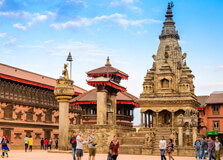
Bhaktapur Durbar Square is one of the most well-preserved royal palace complexes in the Kathmandu Valley and a UNESCO World Heritage Site. Located in Bhaktapur, a historic town about 13 kilometers east of Kathmandu, this square is a living museum of ancient Nepali culture, art, and architecture. The square is surrounded by magnificent temples, courtyards, palaces, and statues that reflect the glorious era of the Malla dynasty. Bhaktapur, which translates to "City of Devotees," offers a glimpse into Nepal’s medieval past and is especially known for its craftsmanship, pottery, and traditional lifestyle. How to Reach Bhaktapur Durbar Square, Kathmandu Bhaktapur Durbar Square is about a 30 to 45-minute drive from Kathmandu, depending on traffic. The most convenient way to get there is by taxi or private vehicle. Taxis are readily available in Kathmandu, and most drivers are familiar with the route to Bhaktapur. Budget travelers can take local buses or microbuses from Kathmandu. Buses leave regularly from Ratna Park or Bagbazaar and go directly to Bhaktapur. You can get off at the Bhaktapur Bus Park, which is a 10-15 minute walk from the Durbar Square. Public transportation is cheaper but may be crowded and less comfortable. Weather Bhaktapur enjoys a similar climate to Kathmandu. The best time to visit is during the spring (March to May) and autumn (September to November) seasons. During these months, the weather is pleasant, with clear skies and mild temperatures ranging between 15°C to 25°C, ideal for sightseeing and photography. Monsoon season (June to August) brings heavy rains, which can make walking around the square a bit challenging. However, the rains also bring out the natural beauty of the town, making the surroundings lush and green. Winters (December to February) are cool and dry, with temperatures dropping to around 5°C in the mornings and evenings. A light jacket is recommended if you're visiting during this time. Timing Bhaktapur Durbar Square is open to visitors every day from 7:00 AM to 7:00 PM. Most of the monuments and museums in the square are accessible during daylight hours, typically from 9:00 AM to 5:00 PM. It’s best to visit early in the morning to enjoy the peaceful ambiance and avoid large crowds, especially during tourist season. Guided tours are available, and local guides can help explain the historical and cultural significance of the various temples and monuments in the square. Why Famous for Bhaktapur Durbar Square, Kathmandu? Bhaktapur Durbar Square is famous for its artistic beauty, historical significance, and architectural excellence. Unlike the other Durbar Squares in Kathmandu and Patan, Bhaktapur retains much of its old-world charm. The square is a showcase of Newari culture and craftsmanship, with intricate wood carvings, pagoda-style temples, and beautifully designed courtyards. It is also known for being a hub of traditional art and culture. Bhaktapur is still home to many artisans, including potters, woodcarvers, and metal workers, who continue to practice centuries-old techniques. The city's commitment to preserving its heritage makes it a unique destination in Nepal. Entry and Visit Details about Bhaktapur Durbar Square, Kathmandu There is an entry fee to visit Bhaktapur Durbar Square. As of recent updates: Foreign tourists: NPR 1,500 SAARC nationals: NPR 500 Chinese tourists: NPR 500 Nepali citizens: Free Tickets can be purchased at the main entrance gates to the square. The ticket allows access to multiple sites within the Bhaktapur area, including the 55-Window Palace, Vatsala Temple, and the National Art Gallery. Local guides are available and can be hired at an additional cost. History and Architecture Bhaktapur Durbar Square was the royal palace of the Malla kings who ruled the Bhaktapur Kingdom from the 14th to the 18th centuries. During this time, the square flourished as a center of politics, culture, and religion. Much of the architecture seen today was developed during the reign of King Bhupatindra Malla, who was known for his patronage of the arts. The square is home to some of the finest examples of traditional Newari architecture. Major highlights include: 55-Window Palace: A grand palace built in the 15th century, known for its unique wooden windows and artistic design. Vatsala Temple: A stone temple dedicated to the goddess Vatsala Devi, featuring a bell known as the "Bell of Barking Dogs." Nayatapola Temple: Located nearby in Taumadhi Square, this five-story pagoda is the tallest temple in Nepal and a masterpiece of pagoda architecture. Golden Gate: An ornate gate considered one of the most beautiful in the world, serving as the entrance to the palace courtyard. The 2015 earthquake damaged some parts of the square, but extensive restoration work has helped bring back its historical charm. Things to Do at Bhaktapur Durbar Square, Kathmandu Explore Historic Temples: Visit the many temples and shrines scattered across the square and surrounding areas. Visit the National Art Gallery: Learn about Nepalese art through traditional paintings, sculptures, and ancient manuscripts. Watch Traditional Craftsmanship: Observe artisans making pottery, wood carvings, and metal works in nearby workshops. Enjoy Local Food: Try famous Bhaktapur specialties like Juju Dhau (king curd), Bara, and Newari cuisine at local eateries. Attend Cultural Festivals: If visiting during a festival like Bisket Jatra or Gai Jatra, you’ll witness traditional music, dance, and celebrations. Photography: The historic architecture and street life make Bhaktapur a paradise for photographers. Facts and Tips about Bhaktapur Durbar Square, Kathmandu Bhaktapur was once a separate kingdom before Nepal was unified. The city is also known as "Bhadgaon" or "Khwopa" in Newari language. It’s a car-free zone, so wear comfortable shoes and be ready to walk. Try Juju Dhau, a sweet yogurt delicacy unique to Bhaktapur. Hire a local guide for a deeper understanding of the history and symbolism of the monuments. Respect local customs, especially when entering temples—remove your shoes and dress modestly. Plan to spend at least half a day to explore the square and nearby attractions like Taumadhi and Dattatreya Squares. Conclusion Bhaktapur Durbar Square is not just a historical site; it’s a living representation of Nepal’s artistic soul and cultural richness. With its beautifully preserved architecture, vibrant street life, and deep historical roots, Bhaktapur offers an unforgettable experience to visitors. Whether you're an art lover, a history buff, or a curious traveler, this ancient square is sure to leave you enchanted. Make sure to add Bhaktapur Durbar Square to your Kathmandu Valley itinerary to witness the heart of medieval Nepal in its most authentic form.
Explore More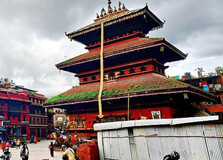
Taumadhi Square is one of the most vibrant and culturally rich public squares located in the historic city of Bhaktapur, Nepal. It is part of the greater Bhaktapur Durbar Square area and is home to some of the city's most iconic landmarks, including the famous Nyatapola Temple and Bhairabnath Temple. Surrounded by traditional Newari architecture, ancient temples, and lively local life, Taumadhi Square is a favorite destination for both domestic and international visitors. It’s a perfect place to witness Nepal’s living heritage, where religion, culture, art, and daily life blend seamlessly. How to Reach Taumadhi Square, Bhaktapur Taumadhi Square is situated at the heart of Bhaktapur, about 13 kilometers east of Kathmandu. Here's how you can reach it: By Taxi: A taxi ride from Kathmandu takes around 30–45 minutes. This is the most convenient way to reach Bhaktapur directly. By Local Bus: You can take a local bus or microbus from Ratna Park or Bagbazar in Kathmandu. Get off at Kamalbinayak or Bhaktapur Bus Park, and from there, it's a 10–15-minute walk. Walking: Once inside Bhaktapur Durbar Square, Taumadhi Square is just a few minutes' walk away. It's well connected by pedestrian alleys. Weather at Taumadhi Square, Bhaktapur Bhaktapur enjoys a mild and pleasant climate for most of the year. The weather at Taumadhi Square varies by season: Spring (March to May): Warm and clear, perfect for sightseeing and photography. Monsoon (June to August): Heavy rains are common. The area can be slippery, so carry an umbrella or raincoat. Autumn (September to November): The best time to visit—cool and dry with beautiful skies. Winter (December to February): Chilly mornings and evenings, but usually sunny during the day. Timing of Taumadhi Square, Bhaktapur Taumadhi Square is an open public space and can be visited at any time. However, if you want to visit temples or museums: Opening Time: Around 6:00 AM Closing Time: Around 7:00 PM Morning hours are peaceful and great for photography, while evenings are lively with local activity. Why is Taumadhi Square Famous? Taumadhi Square is famous for being home to the tallest temple in Nepal—Nyatapola Temple. It is also known for its unique architectural beauty, stone sculptures, and vibrant cultural activities. The square plays a major role during festivals such as Bisket Jatra, one of Bhaktapur's biggest annual celebrations. The blend of spiritual significance, architectural beauty, and local life makes Taumadhi Square an unforgettable experience for all who visit. Entry and Visit Details about Taumadhi Square, Bhaktapur To access Taumadhi Square, visitors must pay the Bhaktapur city entrance fee: Foreigners: NPR 1,500 SAARC Nationals: NPR 500 Nepali Citizens: Free entry The ticket allows access to Bhaktapur Durbar Square, Taumadhi Square, and other nearby heritage sites for the whole day. Guided tours are available and highly recommended for deeper insights into the history and significance of the temples. History and Architecture of Taumadhi Square Taumadhi Square has a long and rich history dating back to the Malla period, around the 17th century. It was a central location for royal processions, religious events, and community gatherings. The square is best known for the **Nyatapola Temple**, a five-storied pagoda built by King Bhupatindra Malla in 1702. It stands 30 meters tall and is one of the tallest and strongest temples in Nepal. The temple is dedicated to the goddess Siddhi Lakshmi and showcases traditional Newari architecture. Another important structure in the square is the **Bhairabnath Temple**, dedicated to the fearsome god Bhairab. Unlike Nyatapola, which is tall and elegant, this temple is known for its bold and fierce design. The square itself is paved with red bricks and surrounded by beautifully carved buildings, stone lions, and traditional wooden windows, making it a living museum of medieval art. Things to Do at Taumadhi Square Taumadhi Square offers a rich cultural and historical experience. Here are some things you can do: Climb up the Nyatapola Temple for a panoramic view of Bhaktapur. Explore Bhairabnath Temple and learn about Hindu rituals. Watch locals make pottery, wood carvings, or metal crafts. Enjoy local food like Juju Dhau (King Curd) and Bara at nearby eateries. Attend or witness festivals like Bisket Jatra if visiting in April. Shop for traditional crafts, paintings, and souvenirs in local shops. Sit back and relax on the temple steps and observe daily life around you. Interesting Facts about Taumadhi Square, Bhaktapur Nyatapola Temple has survived multiple earthquakes due to its strong design and solid foundation. The five stories of Nyatapola represent five basic elements—earth, water, fire, air, and sky. Each pair of guardian statues in front of the temple is ten times stronger than the one below it. The square is an active community space where locals still gather daily for ceremonies and markets. The square is named “Taumadhi” from the Newari word "Tawamari," meaning “resting place.” Tips for Visiting Taumadhi Square, Bhaktapur Visit early in the morning or during golden hour for the best lighting and fewer crowds. Respect religious customs—remove your shoes before entering temples. Hire a local guide to understand the deeper history and stories behind the temples. Carry cash, as local markets and ticket counters may not accept cards. Wear comfortable walking shoes, as the square is paved with uneven bricks. If visiting during a festival, be prepared for large crowds and loud celebrations. Don’t forget to try local snacks and buy handmade crafts from local artisans.
Explore More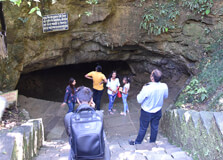
Mahendra Cave is one of the most famous natural attractions in Pokhara, Nepal. Located around 8 kilometers from the lakeside area, it draws thousands of visitors each year due to its stunning geological formations, rich history, and the cultural significance it holds for locals. The cave, named after the late King Mahendra of Nepal, is a popular spot for tourists who seek adventure and a chance to explore one of the region’s most unique natural wonders. The cave is a limestone cavern that has fascinating stalactites and stalagmites, adding to the intrigue of the site. How to Reach Mahendra Cave, Pokhara Mahendra Cave is located just a short distance from the main Pokhara city, making it easily accessible for visitors. From Lakeside, you can hire a taxi or take a local bus to the cave entrance. It is approximately 8 kilometers away from the Lakeside area, and the drive will take you around 20 minutes, depending on traffic. For those who prefer a more adventurous route, you can rent a bicycle or motorbike to reach the cave. Once you arrive at the cave entrance, a short hike up a small hill will lead you to the entrance. The path is well-marked and easy to follow. Weather at Mahendra Cave, Pokhara The weather in Pokhara, including around Mahendra Cave, follows a subtropical climate. The best time to visit the cave is during the cooler months of the year, particularly from October to March. During these months, the weather is clear, cool, and dry, making it perfect for outdoor activities. Summer months, from April to June, can be hot, with temperatures ranging from 25°C to 35°C, but the cave still remains a cool respite due to its underground nature. The monsoon season from June to September brings heavy rainfall, which can make the trails slippery, so it's best to avoid visiting during this period. Timing of Mahendra Cave, Pokhara Mahendra Cave is open to visitors every day from 9:00 AM to 5:00 PM. The cave is accessible throughout the week, and there are no specific restrictions on visiting times. However, to avoid the crowds, it is advisable to visit early in the morning or late in the afternoon. The lighting inside the cave is minimal, so visitors are advised to bring a flashlight, although there are electric lights at the entrance. If you prefer a more quiet experience, it’s best to visit during the off-peak season or early in the day. Why Famous for Mahendra Cave, Pokhara? Mahendra Cave is famous for its natural beauty and its intriguing geological features. The cave is a limestone formation that is filled with impressive stalactites and stalagmites, which have formed over thousands of years. The cave also has a rich history, as it was named after King Mahendra of Nepal, who was a popular ruler. Locals and tourists alike are drawn to the cave for its spiritual significance, as well as its beauty. The cave is also famous for its cool interior, which provides a refreshing escape from the hot weather outside. The proximity to Pokhara city also makes it an easy and popular destination for tourists exploring the area. Entry and Visit Details about Mahendra Cave, Pokhara The entrance fee to Mahendra Cave is minimal. For Nepali nationals, the entry fee is usually around NPR 100, while foreign tourists are typically required to pay an entry fee of NPR 150-200. There are no additional charges unless you wish to hire a guide. Guides are available at the entrance and can provide valuable information about the history and geological features of the cave. Visitors should be prepared to walk through the cave, which is mostly uneven and can be slippery in some areas. Proper footwear, like sturdy shoes or sandals with grip, is recommended. History and Architecture of Mahendra Cave, Pokhara Mahendra Cave was discovered many years ago and has been a popular destination ever since. The cave is named after King Mahendra, who reigned in Nepal from 1955 to 1972, and the cave's name is a tribute to his reign. The architecture of the cave is naturally formed from limestone deposits over thousands of years. The stalactites (hanging formations) and stalagmites (formations that grow upwards from the floor) are some of the most striking features of the cave. The cave is believed to have had some spiritual significance, as many locals come here to seek blessings from the gods. The cool, dark atmosphere of the cave makes it an ideal place for meditation, prayer, and reflection. Things to Do at Mahendra Cave, Pokhara Visitors to Mahendra Cave can enjoy various activities that allow them to explore the natural beauty of the site and the surrounding area. Some of the things to do at the cave include: Exploring the cave: Walk through the limestone cavern and admire the unique geological formations of stalactites and stalagmites. Photography: Capture the beauty of the cave's interior with a camera, especially the fascinating rock formations. Spiritual experience: Many visitors find the cool, quiet atmosphere of the cave to be perfect for meditation and reflection. Hiking: The short hike up to the cave offers stunning views of the surrounding area, including the nearby hills and Pokhara valley. Visit the nearby Bat Cave: Another nearby cave, the Bat Cave, is often visited in conjunction with Mahendra Cave, as it is located close by. Facts about Mahendra Cave, Pokhara Here are some interesting facts about Mahendra Cave: The cave is a limestone formation, which means it was created by the erosion of rock over thousands of years. Mahendra Cave is home to a variety of bats, which can often be seen hanging from the ceiling, particularly in the quieter, darker sections of the cave. The cave has a cool interior, which makes it a refreshing destination to visit during the hot summer months. The cave is not very large, but it is deep enough to allow for an interesting exploration experience. Locals believe that the cave is sacred, and many come to the cave to meditate and pray in its serene atmosphere. Tips about Mahendra Cave, Pokhara Here are some helpful tips for visiting Mahendra Cave: Wear comfortable, sturdy shoes or sandals with good grip, as the cave can be slippery in places. Bring a flashlight or ensure your phone has a torch function, as the cave has low lighting in some areas. Bring water with you, especially if visiting in the summer months, as the hike to the cave can be slightly strenuous. Be cautious when walking through the cave, as there are uneven surfaces and small rocks. Consider visiting the nearby Bat Cave, which is another popular natural attraction in the area. Visit early in the day or late in the afternoon to avoid the crowds and enjoy a peaceful experience. In conclusion, Mahendra Cave is a fascinating destination for those interested in natural beauty, adventure, and history. Its unique geological formations, serene atmosphere, and proximity to Pokhara make it a must-visit site for travelers to this beautiful city. Whether you're an avid adventurer or just looking for a quiet place to reflect, Mahendra Cave offers something for everyone.
Explore More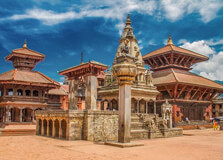
Patan Durbar Square is one of the most remarkable and culturally rich heritage sites in Nepal. Located in the city of Lalitpur, also known as Patan, it is a UNESCO World Heritage Site and a prime example of Newar architecture. The square is a living museum filled with stunning temples, intricately carved windows, traditional courtyards, and ancient palaces. It reflects the architectural brilliance and artistic achievements of the Malla kings, who ruled over Patan from the 12th to the 18th centuries. Patan Durbar Square is not just a tourist spot, but a center of spiritual and cultural life for locals. How to Reach Patan Durbar Square, Patan Reaching Patan Durbar Square is easy from Kathmandu and other surrounding areas: By Taxi: Taxis are readily available from anywhere in Kathmandu. The ride to Patan Durbar Square takes about 20–30 minutes, depending on traffic, and costs around NPR 500–700. By Public Bus: Public buses and microbuses are available from various parts of Kathmandu, such as Ratna Park and Lagankhel, and they are much cheaper than taxis. By Rickshaw: Cycle rickshaws and electric tuk-tuks are available for short distances within Patan and nearby areas. On Foot or By Bicycle: If you're staying nearby, you can walk or cycle to the square. It’s a pleasant and scenic route for those who enjoy urban walks. Weather at Patan Durbar Square, Patan The weather in Patan is similar to Kathmandu as both lie within the same valley. It has a moderate climate throughout the year: Spring (March to May): Temperatures range from 16°C to 28°C. The skies are mostly clear, and flowers bloom all around the square, making it an ideal time to visit. Summer/Monsoon (June to August): This season brings heavy rain with warm temperatures between 22°C and 30°C. The square remains beautiful, but you’ll need an umbrella or raincoat. Autumn (September to November): One of the best seasons to visit, the temperature ranges from 15°C to 26°C with clear skies, perfect for sightseeing and photography. Winter (December to February): The weather is dry and cool with temperatures between 8°C and 20°C. Mornings and evenings can be chilly, but the afternoons are generally pleasant. Timing of Patan Durbar Square, Patan Patan Durbar Square is open to visitors every day: Opening Hours: 9:00 AM to 5:00 PM (Daily) Best Time to Visit: Early morning or late afternoon when the light is perfect and the crowds are smaller. Why Famous for Patan Durbar Square, Patan? Patan Durbar Square is famous for its beautiful temples, traditional palaces, and historical significance. Here’s why it draws thousands of visitors each year: Architectural Wonder: The square is home to some of the best-preserved examples of Newari architecture. The intricate carvings and traditional pagoda-style temples are a sight to behold. Cultural Hub: The square is an active cultural center where festivals, rituals, and ceremonies take place year-round. Historical Importance: It was once the royal palace of the Malla kings who ruled the Kathmandu Valley, making it a site of great historical significance. UNESCO World Heritage Site: Recognized for its outstanding universal value and historical architecture, the square has been a protected UNESCO site since 1979. Entry and Visit Details about Patan Durbar Square, Patan Here are the essential details you need for visiting: Entry Fee: Foreigners: NPR 1,000 SAARC Nationals: NPR 250 Locals: Free or nominal entry Guided Tours: Available at the entrance or through local travel agencies. Guides can explain the history and importance of the temples and artifacts. Photography: Allowed in most areas, but some temples or interiors may have restrictions. History and Architecture of Patan Durbar Square, Patan Patan Durbar Square has a long and rich history dating back to the Licchavi period (3rd to 9th century), though most of the structures seen today were built or renovated during the Malla period (16th to 18th century). The square was the center of political and cultural life in Patan and served as the royal palace of the Malla kings. The architecture in the square is a blend of Hindu and Buddhist styles. Notable buildings include: Krishna Mandir: A 17th-century stone temple built by King Siddhi Narsingh Malla. It is one of the few temples in Nepal built entirely from stone. Hiranya Varna Mahavihar (Golden Temple): A stunning Buddhist monastery with intricate golden details and carvings. Taleju Bhawani Temple: Dedicated to the royal goddess Taleju, this temple was reserved for royal family members. Patan Museum: Located inside the old palace, it displays historical artifacts, religious art, and traditional architecture. Things to Do at Patan Durbar Square, Patan There are plenty of activities for visitors to enjoy at Patan Durbar Square: Visit Patan Museum: One of Nepal’s best museums, showcasing centuries-old artwork and artifacts. Explore the Temples: Walk around and admire the many temples, shrines, and courtyards each with its own story and design. Photography: The square is a paradise for photographers with its rich colors, detailed carvings, and beautiful street life. Shopping for Handicrafts: Patan is known for its metalwork and handicrafts. Visit local shops and galleries to see artisans at work and buy souvenirs. Cultural Events and Festivals: If you're lucky, you may witness a local festival like Indra Jatra or Rato Machindranath Jatra, which bring the square alive with music, dance, and rituals. Facts and Tips about Patan Durbar Square, Patan Fact 1: Patan Durbar Square has more than 50 temples, each unique in its design and historical significance. Fact 2: Many parts of the square were damaged during the 2015 earthquake but have been beautifully restored. Tip 1: Wear comfortable shoes, as you’ll be walking a lot on stone pavements and uneven surfaces. Tip 2: Respect local customs and avoid entering temples where non-Hindus are not allowed. Tip 3: Hiring a local guide can enhance your experience by providing historical context and interesting stories. Tip 4: Carry cash in Nepalese Rupees for entrance fees and local purchases, as card facilities may be limited. Patan Durbar Square is more than just a historical site—it is a vibrant part of everyday life in Patan. The combination of art, architecture, culture, and religion makes it one of Nepal’s most treasured places to visit. Whether you’re interested in history or simply want to experience the charm of ancient Nepal, a visit to Patan Durbar Square is sure to leave a lasting impression.
Explore More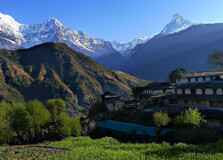
Sagarmatha, known worldwide as Mount Everest, is the highest mountain on Earth with an elevation of 8,848.86 meters (29,031.7 feet). It is located in the Solukhumbu district of Nepal. The region is part of the Sagarmatha National Park and is a UNESCO World Heritage Site. Solukhumbu is not only famous for hosting Mount Everest but also for its rich Sherpa culture, beautiful landscapes, monasteries, and trekking routes. How to Reach Sagarmatha and Solukhumbu Reaching Sagarmatha and Solukhumbu starts with a flight from Kathmandu to Lukla, which is a small mountain airstrip and considered one of the most thrilling airports in the world. From Lukla, travelers usually trek through villages like Namche Bazaar, Tengboche, and Dingboche to reach Everest Base Camp. There are no direct roads to the region, so trekking or using helicopters are the only ways to get deeper into the area. Weather and Best Time to Visit The weather in Sagarmatha and Solukhumbu can be quite extreme due to the high altitude. Winters (December to February) are very cold and not suitable for trekking. The best time to visit is during the spring (March to May) and autumn (September to November). These seasons offer clear skies, moderate temperatures, and the best mountain views. Monsoon season (June to August) brings heavy rains and is usually avoided by trekkers. Why Is Sagarmatha and Solukhumbu Famous? Sagarmatha is globally known as the tallest peak on Earth, attracting climbers and adventurers from all over the world. The Solukhumbu region is famous for its breathtaking mountain scenery, Buddhist monasteries, Sherpa villages, and the challenging trekking trails leading to Everest Base Camp. The culture, hospitality, and spirit of the people living in this high-altitude region also make it a very special place. Entry and Visit Details To enter Sagarmatha National Park, visitors need to obtain permits. The two main permits are the Sagarmatha National Park Entry Permit and the Khumbu Pasang Lhamu Rural Municipality Permit. These can be obtained in Kathmandu or at entry points like Monjo. No vehicles can reach the interior parts of Solukhumbu, so all visits require trekking or helicopter rides. History and Architecture The region of Solukhumbu has been home to the Sherpa people for centuries. Their culture is closely tied to Tibetan Buddhism. Many ancient monasteries can be found in the region, including the famous Tengboche Monastery, which is a major spiritual center for Sherpas. The architecture is traditional Himalayan style, with prayer wheels, colorful flags, and stone houses built to withstand the cold and altitude. The region's deep connection with mountaineering began in the 20th century, especially after Sir Edmund Hillary and Tenzing Norgay Sherpa first summited Everest in 1953. Things to Do in Sagarmatha and Solukhumbu There are many exciting and meaningful activities to do in the Sagarmatha and Solukhumbu region: Trek to Everest Base Camp Visit Tengboche Monastery Explore Namche Bazaar – the main trading hub Experience Sherpa culture and lifestyle Climb lesser peaks like Island Peak or Lobuche Photography of the Himalayan landscape Enjoy scenic helicopter tours Interesting Facts about Sagarmatha and Solukhumbu Here are some unique and surprising facts: Mount Everest is called "Sagarmatha" in Nepali and "Chomolungma" in Tibetan. Everest grows by a few millimeters every year due to tectonic activity. Namche Bazaar has internet access even at high altitude. The Sagarmatha National Park is home to rare animals like snow leopards and red pandas. The region supports eco-tourism and sustainable trekking. Tips for Visiting Sagarmatha and Solukhumbu Here are a few tips for travelers planning a trip: Acclimatize properly to avoid altitude sickness – don’t rush the trek. Pack warm clothing even in spring or autumn, as nights can be very cold. Bring cash – there are few ATMs and credit card facilities. Respect the local culture, especially around religious sites. Travel with a guide or a group if you are a first-time visitor. Use reusable bottles to reduce plastic waste in the mountains. Train physically before your trip – the treks are demanding. Conclusion Visiting Sagarmatha and Solukhumbu is a once-in-a-lifetime experience. The region offers majestic mountains, a peaceful environment, and the unique culture of the Sherpa people. Whether you are an adventurer seeking to conquer Everest or a traveler wanting to explore high Himalayan villages, this region has something to offer everyone. With proper preparation and respect for nature and local customs, your journey to Sagarmatha and Solukhumbu will be unforgettable.
Explore More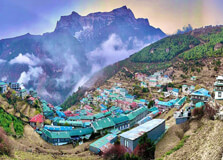
Namche Bazaar is a famous mountain village located in the Solukhumbu district of Nepal. It is often called the "Gateway to Everest" because it is a major stop for trekkers on their way to Everest Base Camp and other high Himalayan trails. Situated at an altitude of 3,440 meters (11,286 feet), Namche Bazaar is known for its scenic beauty, vibrant culture, and as a central trading hub for the Khumbu region. It is surrounded by towering snow-capped peaks and is one of the most developed villages in the high Himalayas. How to Reach Namche Bazaar, Solukhumbu The journey to Namche Bazaar usually begins with a short but exciting flight from Kathmandu to Lukla, which takes about 30–35 minutes. From Lukla, trekkers start walking through several villages including Phakding and Monjo. The trek from Lukla to Namche takes around 2 days depending on your pace and acclimatization schedule. There are no roads for vehicles, so walking or using mules or porters is the only option. Helicopter services are also available for those who prefer a quicker or more comfortable journey. Weather and Best Time to Visit The weather in Namche Bazaar can vary greatly due to its high altitude. Winters (December to February) are extremely cold with snow and freezing temperatures, making it less favorable for trekking. The best times to visit are during the spring (March to May) and autumn (September to November). During these months, the weather is stable, skies are clear, and the views of the mountains are breathtaking. Monsoon season (June to August) brings heavy rainfall and is not ideal for trekking due to slippery trails and low visibility. Why Is Namche Bazaar Famous? Namche Bazaar is famous for being the main town in the Everest region. It serves as a trading center where locals from surrounding villages come to buy and sell goods. It is also a popular acclimatization stop for trekkers heading to higher altitudes. The village offers modern facilities like cafes, bakeries, internet cafes, gear shops, and even small museums. The panoramic views of peaks like Kongde Ri, Thamserku, and even distant views of Mount Everest make it a highlight for many visitors. Entry and Visit Details To enter the Solukhumbu region and reach Namche Bazaar, trekkers need two main permits: Khumbu Pasang Lhamu Rural Municipality Permit – required at Lukla. Sagarmatha National Park Entry Permit – required at Monjo. Both permits can be arranged in Kathmandu or at the entry points during the trek. There are many lodges, guesthouses, and teahouses in Namche Bazaar where trekkers can stay. Most places offer basic rooms, meals, hot showers, and even Wi-Fi in some locations. History and Architecture Namche Bazaar has a long history as a trading post. In the past, traders from Tibet and the lower valleys would meet here to exchange goods like salt, wool, rice, and spices. Over time, Namche developed into a bustling town. The architecture of Namche is traditional Himalayan style, with stone-built houses, flat roofs, and colorful decorations. The influence of Tibetan Buddhism is strong, seen in the monasteries, prayer flags, and mani stones scattered throughout the area. Things to Do in Namche Bazaar Although it is mostly known as a rest stop on the way to Everest, Namche Bazaar offers many interesting things to do: Visit the Sherpa Culture Museum and learn about Sherpa history and mountaineering. Hike to the Everest View Hotel for stunning views of Mount Everest and other peaks. Explore nearby villages like Khumjung and Kunde. Shop for local handicrafts, souvenirs, or trekking gear. Relax in mountain cafes and try freshly baked goods or traditional Sherpa meals. Attend the weekly Saturday market where locals trade and sell products. Interesting Facts about Namche Bazaar Here are some fascinating facts about Namche Bazaar: Namche is one of the highest permanently inhabited towns in the world. It is located inside Sagarmatha National Park, a UNESCO World Heritage Site. It has one of the highest located Irish pubs in the world. Namche has internet and mobile coverage despite its remote location. The first view of Mount Everest for many trekkers is from a hill near Namche. Tips for Visiting Namche Bazaar, Solukhumbu If you're planning to visit Namche Bazaar, here are some helpful tips: Spend at least 2 nights in Namche to acclimatize to the altitude. Drink plenty of water and avoid alcohol in the early days of the trek. Carry cash, as ATMs may not always work and card payments are rare. Hire a local guide or porter for a safer and more enjoyable experience. Be respectful of the local culture, traditions, and religious sites. Buy or rent trekking gear in Namche if you forgot something – it’s well stocked. Try local Sherpa food like "Sherpa stew" or butter tea for a cultural experience. Conclusion Namche Bazaar is more than just a stop on the way to Everest – it is a lively village full of culture, history, and natural beauty. Whether you are trekking to Everest Base Camp or simply exploring the Everest region, Namche offers a perfect mix of adventure and comfort. With its friendly people, amazing mountain views, and rich Sherpa traditions, Namche Bazaar is a place that leaves a lasting impression on every traveler.
Explore More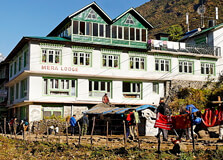
Lukla is a small town located in the Solukhumbu district of Nepal. Nestled in the Himalayas, it is famous worldwide as the gateway to the Everest region and the starting point for many trekkers heading towards Everest Base Camp and other famous Himalayan destinations. Despite its small size, Lukla plays a vital role in Nepal’s trekking industry and attracts thousands of adventurers each year. The town is surrounded by beautiful mountain scenery and offers a glimpse into the unique Sherpa culture of the region. How to Reach Lukla, Solukhumbu The most common way to reach Lukla is by air from Kathmandu, Nepal’s capital. Flights depart from Tribhuvan International Airport in Kathmandu and land at Tenzing-Hillary Airport in Lukla. This airport is famous for its short and challenging runway perched on a mountainside, making it one of the most thrilling and difficult airports for pilots to land on. The flight to Lukla takes about 30 to 40 minutes and offers spectacular aerial views of the Himalayas. Alternatively, some trekkers choose to trek to Lukla from other parts of Nepal, but this requires several days of hiking through remote trails and villages. For most travelers, flying is the most practical and popular option. Weather and Timing in Lukla Lukla experiences a mountain climate with cold winters and mild summers. The weather can be quite unpredictable due to its high altitude of about 2,860 meters (9,383 feet). The best time to visit Lukla and start trekking is during the spring (March to May) and autumn (late September to November) seasons. During these months, the weather is generally clear, temperatures are comfortable, and mountain views are spectacular. The monsoon season (June to August) brings heavy rainfall, making trails slippery and increasing the risk of landslides. Winters (December to February) are cold, with occasional snowfall, but the clear skies offer beautiful views of the snow-capped mountains. Why Is Lukla Famous? Lukla is most famous for being the gateway to Mount Everest and the Everest trekking region. It serves as the main entry point for trekkers heading towards Everest Base Camp, Gokyo Lakes, and other iconic Himalayan destinations. The town is also well known for its airport, which is regarded as one of the most dangerous airports in the world due to its short runway, steep drop, and mountain location. Lukla’s importance lies not only in tourism but also in its role as a hub for Sherpa culture and mountain logistics. Supplies and equipment for Everest expeditions are flown into Lukla and carried by porters to higher elevations, making it a bustling center of activity during trekking seasons. Entry and Visit Details about Lukla, Solukhumbu There is no special entry permit required to visit Lukla itself. However, if you plan to trek beyond Lukla into the Sagarmatha National Park area, you will need permits such as the Sagarmatha National Park Entry Permit and the Khumbu Pasang Lhamu Rural Municipality Permit. These permits can be obtained in Kathmandu or in towns like Monjo near the park entrance. Most visitors spend only a short time in Lukla, either arriving or departing, but some choose to rest here before or after trekking. The town has various guesthouses, tea houses, restaurants, and small shops catering to trekkers. History and Architecture of Lukla Lukla’s history is closely linked to the development of trekking and mountaineering in Nepal. The town grew in importance after the construction of the Lukla airport in the late 1960s, which made access to the Everest region much easier. Before the airport, reaching the region required a long and difficult trek from Jiri or other distant starting points. Architecturally, Lukla reflects typical Sherpa village styles, with stone houses featuring wooden window frames and roofs made from slate or corrugated metal. The town has several small Buddhist monasteries and prayer wheels, demonstrating the religious and cultural influence of Tibetan Buddhism in the area. Things to Do in Lukla Although Lukla is mainly a transit town for trekkers, there are several things visitors can enjoy while here: Explore the local market where Sherpa traders sell trekking gear, souvenirs, and local produce. Visit small Buddhist monasteries and observe traditional prayer rituals. Interact with local Sherpa people to learn about their culture and lifestyle. Enjoy panoramic views of nearby mountains like Thamserku and Kusum Kanguru. Rest and prepare for your trek with a hearty meal at one of the many tea houses and restaurants. Interesting Facts about Lukla Here are some interesting facts about Lukla: Lukla’s airport, Tenzing-Hillary Airport, is named after the first climbers to reach Mount Everest’s summit: Tenzing Norgay and Sir Edmund Hillary. The airport’s runway is only about 527 meters (1,729 feet) long and slopes uphill, which helps planes slow down after landing. Lukla is often the starting point for thousands of trekkers and climbers every year who come to the Everest region. Due to its remote location, flights to Lukla are sometimes delayed or canceled because of bad weather, affecting trekking schedules. The town has grown from a small trading post into a lively hub thanks to the popularity of Everest trekking. Tips for Visiting Lukla, Solukhumbu To make the most of your visit to Lukla, keep these tips in mind: Book your flight to Lukla well in advance, especially during peak trekking seasons. Be prepared for possible flight delays or cancellations due to unpredictable mountain weather. Acclimatize properly before starting your trek to avoid altitude sickness. Carry cash, as there are limited ATMs and card facilities in Lukla. Respect local customs and traditions while interacting with the Sherpa community. Travel light but bring warm clothes and proper trekking gear. Stay hydrated and eat well to prepare for your trek ahead. Conclusion Lukla, Solukhumbu is much more than just a transit point; it is an essential gateway to some of the world’s most famous trekking and climbing destinations. Its unique airport, rich Sherpa culture, and beautiful mountain surroundings make it a memorable place for travelers. Whether you are beginning your trek to Everest Base Camp or simply exploring the Himalayan foothills, Lukla offers a glimpse into the heart of Nepal’s mountain adventure.
Explore More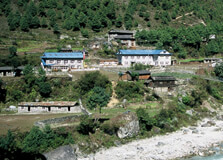
Phakding is a small, charming village located in the Solukhumbu district of Nepal. It is one of the first major stops for trekkers heading towards the Everest region, especially those beginning the famous Everest Base Camp trek. Situated at an altitude of about 2,610 meters (8,563 feet), Phakding offers visitors a beautiful Himalayan landscape combined with authentic Sherpa culture. Surrounded by forested hills and rivers, the village provides a peaceful atmosphere and essential services for travelers preparing to embark on their high-altitude adventure. How to Reach Phakding, Solukhumbu Phakding is accessible primarily by trekking, as it lies on the popular trekking trail between Lukla and Namche Bazaar. Most trekkers fly from Kathmandu to Lukla’s Tenzing-Hillary Airport, which is considered the gateway to the Everest region. From Lukla, it takes about 3 to 4 hours of walking along well-marked trails to reach Phakding. The trek from Lukla to Phakding is relatively gentle compared to the higher sections of the Everest trail and is often used by trekkers to acclimatize to the altitude gradually. The trail follows the Dudh Koshi River, crossing suspension bridges and passing small villages and forests. While Phakding itself is not accessible by road, the trekking route is clearly marked and well-maintained. Weather and Timing in Phakding The weather in Phakding is generally mild and pleasant during the main trekking seasons, spring (March to May) and autumn (September to November). During these times, temperatures can range from about 10°C to 20°C during the day but can drop significantly at night. The winter months (December to February) are colder, with temperatures often falling below freezing at night, and snow can occasionally fall. The summer monsoon season (June to August) brings heavy rains, making the trails muddy and sometimes dangerous. Most trekkers avoid visiting during the monsoon season because of the increased risk of landslides and poor visibility. Why Is Phakding Famous? Phakding is famous for being the first significant stop on the trek to Everest Base Camp. It serves as a rest point for trekkers after their flight into Lukla, offering a chance to acclimatize and prepare for the more challenging sections ahead. The village is well-known for its traditional Sherpa hospitality, with many teahouses, guesthouses, and lodges that welcome travelers. Additionally, Phakding is located near the Sagarmatha National Park entrance, a UNESCO World Heritage Site, making it an important location for obtaining trekking permits. Its proximity to the Dudh Koshi River and the scenic surroundings also make it a beautiful place for nature lovers. Entry and Visit Details about Phakding, Solukhumbu Visitors do not need any special entry permits to visit Phakding village itself. However, if you plan to trek further into the Everest region beyond Phakding, you will need two essential permits: the Sagarmatha National Park Entry Permit and the Khumbu Pasang Lhamu Rural Municipality Permit. These permits can be obtained in Kathmandu before the trek or at the park entrance near Monjo village. Phakding offers several guesthouses and tea houses where trekkers can stay overnight. Facilities here are basic but comfortable, with warm meals and resting areas. Since Phakding is one of the first stops, it is often less crowded than other villages higher up the trail. History and Architecture of Phakding Phakding has a rich Sherpa heritage and traditional Himalayan mountain village architecture. The village has been a part of the ancient trade and trekking routes for centuries, connecting Tibet and Nepal. The Sherpa people, known for their mountaineering skills and close relationship with the mountains, have lived in Phakding and surrounding villages for generations. Architecturally, the village features stone-built houses with wooden window frames and slanted roofs made from slate or corrugated metal. Small Buddhist prayer walls, mani stones, and chortens (stupas) are scattered throughout the village, reflecting the deep spiritual and religious traditions of the Sherpa community. Things to Do in Phakding Though Phakding is a small village, there are several activities and experiences for visitors: Enjoy Trekking: Use Phakding as a base to explore nearby trails and acclimatize before heading higher on the Everest trek. Visit Local Monasteries: Explore small Buddhist temples and prayer sites to learn about Sherpa religious culture. Nature Walks: Walk along the banks of the Dudh Koshi River and enjoy the stunning Himalayan scenery and wildlife. Interact with Locals: Spend time with Sherpa families, learning about their lifestyle, customs, and traditions. Photography: Capture breathtaking views of mountains, forests, and the quaint village life. Facts about Phakding Here are some interesting facts about Phakding: Phakding lies at about 2,610 meters (8,563 feet) above sea level, making it a moderate altitude for initial acclimatization. The village is situated along the Dudh Koshi River, one of the major rivers in the Everest region. Phakding is a critical rest stop for trekkers, with several tea houses providing food and lodging. The village is surrounded by rhododendron forests that bloom beautifully during spring. It is part of the Sagarmatha National Park, which is known for its diverse flora and fauna. Tips for Visiting Phakding, Solukhumbu To make your visit to Phakding enjoyable and safe, consider the following tips: Take your time to acclimatize properly in Phakding to reduce the risk of altitude sickness. Bring enough warm clothing, especially for nights, which can get cold even during the trekking season. Stay hydrated and carry water purification tablets or filters as clean water is essential. Respect local customs and traditions, and ask permission before photographing people. Carry some cash, as there are limited ATM facilities in the village. Try local Sherpa cuisine such as dal bhat (lentil soup with rice) to experience authentic flavors. Walk slowly and enjoy the beautiful surroundings rather than rushing through the trek. Conclusion Phakding is more than just a stopover village; it is a welcoming gateway into the Everest region. With its friendly Sherpa culture, beautiful natural environment, and important location on the trekking trail, it offers a peaceful and authentic experience for travelers. Whether you are beginning your trek to Everest Base Camp or simply exploring the Solukhumbu region, Phakding provides a perfect introduction to the majestic Himalayas and the fascinating culture that thrives in their shadow.
Explore More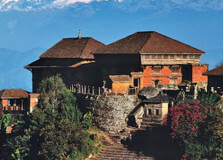
Gorkha Durbar is a historic palace located in Gorkha, a district in western Nepal. Sitting on a hilltop, this ancient palace complex offers a fascinating glimpse into Nepal’s royal and cultural history. It was the home of King Prithvi Narayan Shah, the founder of modern Nepal, who unified many small kingdoms into one nation in the 18th century. The Gorkha Durbar is a blend of a royal palace, fort, and temple. Its impressive structure and location make it not only a significant historical site but also a popular destination for both tourists and pilgrims. The site is known for its beautiful architecture, panoramic views, and spiritual importance. How to Reach Gorkha Durbar, Gorkha Gorkha Durbar is located above Gorkha Bazaar and can be reached by road followed by a short hike. Here are the options to reach the site: From Kathmandu: Regular buses and private vehicles travel from Kathmandu to Gorkha Bazaar. The journey takes approximately 5–6 hours. From Pokhara: Gorkha is around 4 hours by road from Pokhara. Buses and jeeps are available daily. From Gorkha Bazaar: The palace is located on a hill above the market. It takes about 30 to 45 minutes to walk up the well-maintained stone steps to reach the Durbar. The climb is steep but rewarding, with resting spots and great views along the way. Weather and Best Time to Visit The climate in Gorkha is moderate, with warm summers, cool winters, and pleasant weather in between. The best time to visit Gorkha Durbar is: Spring (March to May): Ideal weather, clear skies, and colorful flowers in the surrounding hills. Autumn (September to November): Crisp air and clear mountain views, perfect for sightseeing and hiking. Winters (December to February) can be cold in the early morning and evening, while monsoon season (June to August) brings rain and slippery trails. Why is Gorkha Durbar Famous? Gorkha Durbar holds immense historical and cultural importance in Nepal. It is famous for several reasons: Birthplace of a King: It was the royal residence of King Prithvi Narayan Shah, who unified Nepal. Historic Unification: From this palace, the campaign to unite Nepal’s many kingdoms began in the 18th century. Architectural Beauty: The palace features a unique mix of traditional Nepali, Newari, and fortress-style architecture. Spiritual Significance: The site includes temples dedicated to Gorakhnath and Kali, attracting pilgrims year-round. Breathtaking Views: The hilltop offers stunning panoramic views of the Himalayas and surrounding valleys. Entry and Visit Details Visiting Gorkha Durbar is open to all and is quite affordable. Below are the essential details for visitors: Opening Hours: Daily from 9:00 AM to 5:00 PM. Closed during national holidays or special rituals. Entry Fee: Nepali citizens: Free; Foreigners: A small fee (usually under NPR 200; check locally for updates). Guided Tours: Local guides are available at the base of the steps or through hotels in Gorkha Bazaar. Footwear: Visitors are required to remove their shoes before entering the temple parts of the complex. History and Architecture Gorkha Durbar was built in the 16th century by Ram Shah, a king of the Gorkha kingdom. The palace became especially significant when his descendant, King Prithvi Narayan Shah, launched the unification of Nepal from this very place in the 18th century. The architectural style is a stunning combination of fortress-like walls, intricate wooden carvings, and traditional tiered pagodas. Inside the complex, there are two major religious sites: the Kalika Temple and the Gorakhnath Temple. The Kalika Temple features intricate carvings and is known for its religious rituals, while the Gorakhnath Cave is a sacred meditation site. The palace was damaged during the 2015 earthquake, but restoration work is ongoing to preserve its historical and cultural value. Things to Do at Gorkha Durbar Visit the Palace: Explore the historic royal residence and learn about Nepal's unification. Worship at the Temples: Offer prayers at the Kalika and Gorakhnath temples. Photography: Capture panoramic views and detailed woodwork of the palace. Hike the Steps: Enjoy the scenic hike from Gorkha Bazaar to the Durbar, especially at sunrise or sunset. Local Culture: Interact with locals, visit nearby shops, and experience the rich traditions of Gorkha. Interesting Facts about Gorkha Durbar The palace sits at an elevation of around 1,400 meters above sea level. “Gurkha” soldiers, known worldwide for their bravery, trace their name and legacy back to this region. Gorkha Durbar includes a secret tunnel (now sealed) said to have been used by royals to escape or travel discreetly. The Kalika Temple allows only Hindus inside, but everyone can view it from the outside. The site is part of Nepal’s historical heritage and is being preserved for future generations. Tips for Visiting Gorkha Durbar Start your hike early in the morning to avoid the midday heat and enjoy the peaceful atmosphere. Wear comfortable shoes, as the stone steps can be steep and uneven. Carry water and light snacks, especially if you're walking up from the bazaar. Be respectful in religious areas—follow local customs and avoid loud conversations. Hire a local guide if you want detailed historical context or cultural explanations. Bring a camera but avoid flash photography inside sacred areas. Conclusion Gorkha Durbar is a place of great national pride, history, and spirituality. It stands as a reminder of Nepal's unification and the powerful legacy of King Prithvi Narayan Shah. The palace, with its temples and scenic views, offers visitors a chance to connect with the heart of Nepal’s history and culture. Whether you're a history lover, spiritual seeker, or curious traveler, a visit to Gorkha Durbar is a meaningful experience. Make sure to include it in your travel plans and take the time to explore this remarkable site that played such an important role in shaping Nepal.
Explore More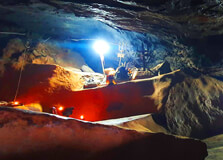
Siddha Cave, located in the beautiful and remote Solukhumbu district of Nepal, is a natural limestone cave known for its spiritual significance and mysterious underground formations. While Siddha Cave in Bandipur is more widely known, the Siddha Cave in Solukhumbu remains a hidden gem—less crowded, more peaceful, and filled with natural and cultural beauty. Nestled in the foothills of the Himalayas, this cave attracts both religious pilgrims and adventure seekers. Locals believe that the cave has been used by yogis and sages for meditation, and that it possesses spiritual energy. The cave features unique rock formations, underground halls, and a tranquil atmosphere that makes it worth visiting for anyone exploring the Everest or Solu region. How to Reach Siddha Cave, Solukhumbu Reaching Siddha Cave in Solukhumbu involves a combination of air travel and trekking or jeep rides, depending on where you are coming from. The most common route is to fly from Kathmandu to Phaplu Airport, which is one of the main airstrips in the lower Solukhumbu region. From Phaplu, you can take a local jeep or trek towards the village closest to Siddha Cave. This journey might take a few hours depending on your route and mode of travel. Alternatively, you can travel by road from Kathmandu to Salleri, the district headquarters of Solukhumbu. From Salleri, local transport and trekking routes lead toward the cave location. The exact access road may vary, so it's recommended to ask locals or hire a local guide who is familiar with the area. Weather and Best Time to Visit The weather around Siddha Cave is typical of the lower Solukhumbu hills—moderate and pleasant during most months of the year. The best time to visit is during the spring (March to May) and autumn (September to November) seasons. During these months, the skies are generally clear, the temperatures are comfortable, and the trails are in good condition. The summer months (June to August) bring heavy monsoon rains, which can make trails muddy and slippery, and cave interiors may become more humid. Winter months (December to February) can be cold, especially in the mornings and evenings, but are still manageable for day visits. Why is Siddha Cave, Solukhumbu Famous? Siddha Cave in Solukhumbu is famous for both its natural wonders and its spiritual legacy. The cave is believed to have been used by “Siddhas,” or enlightened yogis and monks, for meditation and spiritual retreat. Because of this, many local people consider the cave to be sacred, and they visit it for blessings, prayers, and meditation. From a geological point of view, the cave contains impressive stalactites and stalagmites formed over thousands of years. Some of these formations resemble religious symbols or deities, further deepening its spiritual allure. The calm, echoing halls inside the cave offer a truly unique underground experience in the Himalayas. Entry and Visit Details Visiting Siddha Cave is relatively easy once you reach the nearest village or entry point. There is usually a small entry fee charged by the local community, which is used for maintenance and preservation of the site. The cost is minimal and helps support the locals. No special permit is required, unless you're trekking in restricted parts of Solukhumbu, such as the Everest region. Still, it's always a good idea to carry identification and your TIMS (Trekker's Information Management System) card if you are on a longer trekking route. Flashlights or headlamps are highly recommended for cave exploration, as natural light does not enter deep parts of the cave. Guided tours by locals are often available and help in understanding the cave’s spiritual and historical background. History and Architecture Siddha Cave gets its name from the word “Siddha,” meaning enlightened being or spiritual master in Sanskrit. According to local legends, the cave was discovered centuries ago and became a meditative retreat for wandering monks and yogis. Over time, people began to associate the cave with spiritual power, and it became a pilgrimage site. Architecturally, the cave is a natural formation created by the slow erosion of limestone by underground water over thousands of years. It features narrow passageways, high ceilings, and large chambers that open into silent underground halls. The shapes of some rocks and formations inside the cave resemble Shiva Lingams, deities, and other sacred symbols. Things to Do at Siddha Cave, Solukhumbu Explore the Cave: Walk through dark, mysterious corridors filled with natural rock formations. Meditate: Find a quiet corner and meditate in the calm, echo-free environment. Photography: Capture the unique textures, shapes, and natural beauty of the cave. Spiritual Offerings: Locals often light incense or offer flowers inside the cave. Visitors can participate respectfully. Hike: Enjoy the scenic trails leading to and from the cave, surrounded by forests and hills. Talk to Locals: Learn about the legends, stories, and spiritual practices associated with the cave. Interesting Facts about Siddha Cave Siddha Cave is named after yogis who meditated in the Himalayas and are believed to have gained supernatural powers (siddhis). Locals say the cave never ends—though in reality, many parts are unexplored or too narrow to pass through. Echoes inside the cave are almost nonexistent due to the shape of the chambers, creating a unique acoustic experience. Some parts of the cave are naturally shaped like deities and religious symbols, leading locals to worship them. The cave is maintained by nearby villagers, promoting community-based tourism in the Solu region. Tips for Visiting Siddha Cave, Solukhumbu Bring a strong flashlight or headlamp, as parts of the cave are very dark. Wear good hiking shoes with grip—cave floors can be slippery and uneven. Bring a light jacket. Even in warmer months, the inside of the cave remains cool. Respect the spiritual nature of the site. Avoid loud behavior, graffiti, or littering. Hire a local guide for deeper insight and safer navigation inside the cave. Carry water and light snacks, especially if you're combining the visit with a short trek. Check with locals for any festivals or pujas (rituals) that may be happening at the cave during your visit. Conclusion Siddha Cave in Solukhumbu is more than just a natural formation—it's a living part of the region’s culture, spirituality, and folklore. Whether you’re a trekker, a spiritual seeker, or simply someone who loves nature’s hidden wonders, this cave offers a unique experience away from the crowds of the more famous Himalayan destinations. Visiting Siddha Cave is a chance to reflect, explore, and connect with the mystical side of Nepal’s lesser-known beauty.
Explore MoreFrom Sunrise To Sunset - Your Ultimate Guide To Discover Nepal In Just 3 Days Tour
3 Days/ 2 Night
Kathmandu - Nagarkot - Bhaktapur
Nepal Adventure In 5 Days Tour
5 Days/ 4 Night
Kathmandu - Pokhara
Divine Nepal Tour Package – 4 Nights 5 Days
5 Days/ 4 Night
Pokhara - Kathmandu
6 Night - 7 Day Nepal Tour
7 Days/ 6 Night
Kathmandu - Pokhara - Nagarkot - Bhaktapur
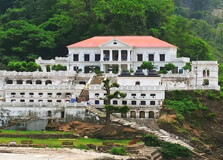
Rani Mahal, often referred to as the "Taj Mahal of Nepal," is a historic and beautiful palace located in the Gorkha district of Nepal. Not to be confused with the more famous Rani Mahal of Palpa, this lesser-known gem in Gorkha holds great historical and emotional significance. Built in honor of a beloved queen, Rani Mahal reflects both love and royal grandeur, surrounded by natural beauty and cultural heritage. This palace is not only a symbol of devotion but also showcases the architectural beauty of a bygone era. Nestled amidst the lush hills and overlooking peaceful valleys, Rani Mahal in Gorkha remains a quiet and majestic destination for history lovers, travelers, and locals alike. How to Reach Rani Mahal, Gorkha Rani Mahal is situated in a serene location in Gorkha district. Here’s how to reach it: From Kathmandu: Take a bus or private vehicle to Gorkha Bazaar (about 5–6 hours). From Gorkha, local transportation or short hikes may be needed, depending on the specific route to the palace. From Pokhara: Gorkha is around 4 hours by vehicle. From Gorkha Bazaar, follow local signage or ask residents for directions to Rani Mahal. By Local Jeep or Walking: The final stretch might require walking, especially if the road is rough or under maintenance. It’s recommended to go with a local guide if you’re unfamiliar with the area. Weather and Best Time to Visit Gorkha enjoys a mild climate most of the year. The best time to visit Rani Mahal is during the following seasons: Spring (March to May): Clear skies, moderate temperatures, and blooming flowers make this the ideal season. Autumn (September to November): Pleasant weather and clear views of the mountains offer a scenic experience. Summer (June to August) brings heavy rains, making the roads slippery and travel less comfortable. Winter (December to February) is generally cold but still manageable with warm clothing. Why is Rani Mahal Famous? Rani Mahal in Gorkha is famous for both its romantic origin and its architectural charm. While it may not be as widely known as other heritage sites, it holds deep meaning for local people and those interested in Nepal’s royal history. Built for Love: The palace was constructed in memory of a queen, symbolizing deep love and royal tribute. Architectural Style: The structure features a beautiful blend of traditional Nepali and European design influences. Cultural Heritage: It represents the royal history of Gorkha, the home of Nepal’s unifying king, Prithvi Narayan Shah. Peaceful Surroundings: Its hilltop location offers peaceful surroundings ideal for reflection and sightseeing. Entry and Visit Details Rani Mahal is open to the public and can be visited during the day. Entry is usually free, though this may vary depending on local authority decisions. Opening Hours: Generally open from 9:00 AM to 5:00 PM. Closed on certain public holidays or during local events. Entry Fee: Typically free or a nominal charge for maintenance. Confirm locally as fees may change. Photography: Allowed in most areas, but it's best to ask before taking pictures inside the palace rooms. Guides: Local guides are available in Gorkha Bazaar if you want a deeper understanding of the site. History and Architecture Rani Mahal’s history is rooted in love and devotion. Though not much is documented officially, local stories say it was built by a ruler or noble in memory of his beloved queen. Inspired by this touching love story, the palace was constructed to reflect grace, elegance, and remembrance. Architecturally, Rani Mahal is a beautiful example of 19th-century design. It showcases a fusion of European influences and Nepali artistry. With large arched windows, high ceilings, balconies, and carved wooden details, the palace displays elegance and craftsmanship. Though time and natural disasters may have worn down parts of the structure, the palace still stands proudly, reminding visitors of Nepal’s royal past. Things to Do at Rani Mahal, Gorkha Explore the Palace: Walk through the old halls, balconies, and rooms to imagine royal life in earlier centuries. Photography: Capture the charm of the architecture and the scenic views from the palace grounds. Picnic: The peaceful surroundings make it an ideal spot for a quiet picnic or a relaxing break. Visit Nearby ��Ӱֱ��: Explore other historical sites in Gorkha, such as Gorkha Durbar and temples. Learn Local Stories: Interact with locals to hear oral histories and legends about the palace and its royal past. Interesting Facts about Rani Mahal, Gorkha The name "Rani Mahal" translates to "Queen’s Palace." It was inspired by love, much like India’s Taj Mahal, although smaller and less elaborate. The palace is lesser known, making it a peaceful, crowd-free destination. It offers panoramic views of nearby hills, rivers, and sometimes even Himalayan peaks on clear days. Rani Mahal is a hidden gem often overlooked by mainstream tourists, but highly valued by heritage lovers. Tips for Visiting Rani Mahal, Gorkha Wear comfortable walking shoes, especially if you're taking a trail or stairs to reach the site. Carry drinking water and snacks, as facilities may be limited near the palace. Check the weather forecast before going, particularly during the monsoon season. Respect local customs and avoid damaging any parts of the structure. Hire a local guide for better insight into the palace's history and stories. Visit during the daytime for safety and to enjoy the views in natural light. Conclusion Rani Mahal in Gorkha is more than just a building—it is a story of love, loss, history, and heritage. Though not as widely visited as other tourist attractions in Nepal, its peaceful atmosphere and romantic legacy make it a special place for those who seek deeper cultural experiences. If you are traveling through Gorkha, take the time to visit this quiet but meaningful monument. Whether you're a history buff, a romantic at heart, or simply someone looking for a serene escape, Rani Mahal is a perfect destination to reflect and connect with Nepal’s royal past.
Explore More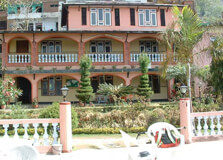
Tundikhel in Gorkha is a wide open ground located in the heart of Gorkha district, known for its historical, cultural, and social importance. Not to be confused with the famous Tundikhel in Kathmandu, this Tundikhel in Gorkha is a peaceful open space that offers panoramic views of the surrounding hills, mountains, and historic sites like Gorkha Durbar. It serves as a central point for gatherings, festivals, local events, and even military parades. Tundikhel has long been a symbol of unity and pride for the people of Gorkha, and it holds great importance in the historical context of Nepal, especially during the unification campaign led by King Prithvi Narayan Shah. How to Reach Tundikhel, Gorkha Tundikhel is easily accessible from Gorkha Bazaar, which is the main town in the district. From Kathmandu: Take a bus or hire a private vehicle to Gorkha Bazaar. The journey takes around 5–6 hours depending on road conditions. From Gorkha Bazaar, Tundikhel is just a short walk or local ride away. From Pokhara: Gorkha is about 4 hours away by road. Once you reach Gorkha Bazaar, follow signs or ask locals for directions to Tundikhel. On Foot: For those exploring the area, Tundikhel is an excellent place to walk to, especially after visiting Gorkha Durbar or nearby temples. Weather and Best Time to Visit Gorkha experiences a temperate climate that is pleasant for most of the year. The best times to visit Tundikhel are: Spring (March to May): Warm days, cool evenings, and blooming flowers make this season ideal for outdoor visits. Autumn (September to November): Clear skies and fresh air offer the best visibility of the mountains and scenic views from Tundikhel. Summer (June to August) brings heavy monsoon rains, which may make the area muddy and less suitable for walking. Winter (December to February) is colder but still manageable with warm clothing. Why is Tundikhel, Gorkha Famous? Tundikhel in Gorkha is famous for multiple reasons: Historical Significance: It was used by the military forces during the unification of Nepal and served as a practice ground for soldiers. Panoramic Views: The location offers a 360-degree view of surrounding hills and mountains, including glimpses of the Manaslu range on clear days. Cultural Events: Local festivals, gatherings, and public speeches often take place here. Proximity to Gorkha Durbar: Located near the historic palace of King Prithvi Narayan Shah, it complements the visit to other heritage sites. Relaxation and Recreation: Today, it serves as a leisure spot for locals and tourists alike. Entry and Visit Details Visiting Tundikhel in Gorkha is simple and accessible for everyone. Opening Hours: Open 24 hours to the public, but it's best visited during daylight. Entry Fee: No entry fee is required. It is a public ground maintained by the local municipality. Best Time to Visit: Early morning or late afternoon for the best light and peaceful environment. Facilities: Limited seating or food stalls, but nearby areas like Gorkha Bazaar offer restaurants and basic services. History and Architecture Tundikhel has been a part of Gorkha’s history for centuries. During the reign of King Prithvi Narayan Shah, this ground was used for military assemblies and training sessions. The open area was strategically important, offering a space where soldiers could gather, practice, and prepare for campaigns. While Tundikhel does not have traditional architectural structures, its location and layout are well-planned. The ground is flat and elevated, with walking paths and sitting areas, offering clear visibility of the valley and mountains. Its simplicity is what makes it attractive—it's nature’s open theater for community life. Things to Do at Tundikhel, Gorkha Enjoy Scenic Views: On a clear day, see snowcapped peaks like Manaslu and the green hills surrounding Gorkha. Photography: Perfect place for landscape photography, sunrise/sunset shots, and historical backdrops. Relax and Picnic: A peaceful place to sit and enjoy local snacks or have a simple picnic. Morning Walks: Locals often walk or exercise here in the early morning or evening. Cultural Interaction: During festivals or events, you can observe and engage in local traditions and dances. Visit Gorkha Durbar: Combine your visit with a trip to the nearby palace and temples for a full cultural experience. Interesting Facts about Tundikhel, Gorkha The name “Tundikhel” means an open plain or parade ground. It played a key role during Nepal’s unification in the 18th century. Tundikhel is used by locals for everything from soccer matches to community gatherings and government events. It is one of the best natural viewpoints in Gorkha for seeing mountain ranges. Many young people gather here during weekends and holidays to relax and enjoy the fresh air. Tips for Visiting Tundikhel, Gorkha Wear comfortable shoes as the area involves walking, especially if you combine your visit with Gorkha Durbar. Bring drinking water and light snacks if you plan to spend more time relaxing there. Visit early morning or evening for cooler temperatures and the best lighting for photography. Respect the local customs, especially during community events or religious festivals. Do not litter—keep the area clean as it is a public space used by many. If you're into sketching or journaling, this is a perfect quiet spot for creativity. Conclusion Tundikhel in Gorkha is more than just an open field—it is a living piece of Nepal’s history and a peaceful place where the community gathers and the culture continues to thrive. Whether you're a tourist seeking views and photos or a history lover tracing the steps of Nepal's unification, Tundikhel offers a calm yet powerful experience. With its scenic location, easy access, and deep cultural value, Tundikhel is a must-visit for anyone exploring the Gorkha region. It invites you to pause, reflect, and connect with the spirit of Nepalese heritage.
Explore More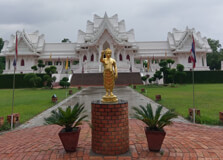
The Royal Thai Buddhist Monastery in Lumbini is one of the most beautiful and serene temples located in the Monastic Zone. Built by the government of Thailand, this monastery is a stunning example of traditional Thai architecture and serves as a spiritual home for Thai Buddhists visiting the birthplace of Lord Buddha. With its gleaming white marble structure, peaceful surroundings, and meditative atmosphere, it is not only a place of worship but also a popular tourist attraction. The monastery reflects Thailand’s deep respect for Buddhism and its cultural connection to Lumbini, the sacred birthplace of Buddha. How to Reach Royal Thai Buddhist Monastery, Lumbini The Royal Thai Monastery is situated in the Western Monastic Zone of Lumbini. It is easily accessible by foot, bicycle, or local rickshaw from the central Maya Devi Temple, which is about 2 kilometers away. Visitors coming from outside Lumbini can reach the monastery via the Gautam Buddha International Airport in Bhairahawa, located approximately 22 kilometers from Lumbini. From the airport, you can take a taxi or local bus to reach the Lumbini Development Zone. You can also enter from the Indian border town of Sonauli and reach Lumbini by road in about an hour. Weather in Lumbini Lumbini experiences a tropical climate. Summers (April to June) are hot and dry, with daytime temperatures ranging from 30°C to 40°C (86°F to 104°F). The monsoon season (July to September) brings regular rainfall and high humidity. Winter (December to February) is the most comfortable season to visit, with temperatures between 8°C to 22°C (46°F to 72°F). The most suitable time to visit the Royal Thai Monastery is during the cooler months between October and March, when the weather is ideal for sightseeing and walking around the Monastic Zone. Timing to Visit Royal Thai Buddhist Monastery The Royal Thai Buddhist Monastery is open to visitors daily from 6:00 AM to 6:00 PM. Entry is free, and tourists are welcome to visit during open hours. Morning and evening hours are the best times to enjoy the monastery’s beauty and peaceful environment, especially for meditation or photography. Why is the Royal Thai Buddhist Monastery Famous? The Royal Thai Buddhist Monastery is famous for its brilliant white architecture and traditional Thai design, which stands out among the many international monasteries in Lumbini. It is a symbol of Thailand’s devotion to Buddhism and its cultural ties to Nepal. The serene environment, beautifully landscaped gardens, and spiritual ambiance attract both pilgrims and tourists. The monastery also functions as a center for Buddhist learning and meditation. Its grand appearance and peaceful atmosphere make it one of the most visited and photographed temples in the Monastic Zone. Entry and Visit Details There is no entry fee for the Royal Thai Monastery. Visitors of all nationalities and backgrounds are welcome to explore the temple grounds, take photos, and experience the peaceful ambiance. As a religious site, visitors should dress modestly and behave respectfully. Shoes must be removed before entering the inner prayer halls. Visitors are also requested to maintain silence or speak softly, especially in meditation areas. History and Architecture The Royal Thai Monastery was built with support from the Thai government and Buddhist community to honor the birthplace of Gautama Buddha. It was one of the early international monasteries established in the Lumbini Development Project. The architecture is heavily influenced by traditional Thai temple designs, featuring tiered roofs, ornate carvings, white marble walls, and golden decorations. The central prayer hall is designed in the style of a Thai Vihara (monastic hall), and the structure as a whole exudes elegance, purity, and peace. The monastery beautifully represents Thailand’s Buddhist heritage and cultural artistry. Things to Do at Royal Thai Buddhist Monastery There are several things you can do while visiting the Royal Thai Buddhist Monastery: Admire the majestic white marble structure and traditional Thai architecture. Walk around the beautifully landscaped gardens and lotus ponds. Sit quietly or meditate in the main prayer hall or outdoor seating areas. Learn about Thai Buddhist practices and rituals by observing monks in prayer. Take photos of the stunning exterior, especially during sunrise or sunset. Attend Buddhist teachings or meditation sessions if scheduled. Explore nearby monasteries in the Western Monastic Zone. Interesting Facts about Royal Thai Buddhist Monastery The monastery is entirely constructed with white marble, symbolizing purity and peace. It is one of the most visited and photographed temples in the Lumbini area. The temple's design is based on classic Thai Buddhist temple architecture seen in Bangkok and Chiang Mai. Monks from Thailand live and practice here, offering a glimpse into Thai monastic life. The monastery is active year-round and often participates in international Buddhist ceremonies. Tips for Visiting Royal Thai Buddhist Monastery Wear modest clothing that covers shoulders and knees, as it is a sacred site. Remove shoes before entering any prayer hall or sacred area. Do not disturb monks during prayer or meditation sessions. Carry water, sunscreen, and a hat if visiting during hot weather. Visit in the morning or late afternoon to avoid the heat and enjoy the lighting for photography. Be respectful of religious customs and avoid loud conversations inside the temple grounds. Take time to sit and meditate—it’s a wonderful place to experience peace and mindfulness.
Explore More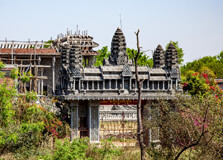
The Cambodian Monastery in Lumbini is one of the most beautiful and culturally rich monasteries located within the Lumbini Development Zone. Also known as the Cambodian International Monastery, it reflects the classical Khmer-style architecture of Cambodia and stands out due to its golden spires, intricate woodwork, and spiritual atmosphere. Built by the Cambodian government and Buddhist community, the monastery serves as a symbol of peace, devotion, and the deep connection between Cambodia and the birthplace of Lord Buddha. How to Reach Cambodian Monastery, Lumbini The Cambodian Monastery is situated in the Monastic Zone of Lumbini, on the eastern side which is dedicated to Theravada Buddhism. It is close to other monasteries such as the Thai Monastery and the Myanmar Golden Temple. Visitors can walk, cycle, or hire electric rickshaws to reach the monastery from the central Lumbini garden or from the main entrance gate. For those coming from outside Lumbini: By Air: The nearest airport is Gautam Buddha International Airport in Bhairahawa, around 22 km away. Taxis and buses are available from the airport. By Road: Lumbini is well-connected to Bhairahawa, Butwal, and other major towns in Nepal. If traveling from India, the nearest border crossing is Sonauli, only about 30 km from Lumbini. By Local Transport: From the Lumbini bus park or entrance gate, you can use a cycle-rickshaw, walk, or rent a bicycle to explore the monastic zone. Weather in Lumbini Lumbini has a tropical climate and experiences the following seasonal variations: Summer (April to June): Hot and dry, with temperatures often crossing 38°C (100°F). Monsoon (July to September): Wet and humid, with frequent rain showers and lush greenery. Winter (October to February): Mild and pleasant, with daytime temperatures between 10°C to 25°C (50°F to 77°F). The best time to visit is from October to March when the weather is cool and ideal for sightseeing and photography. Timing to Visit Cambodian Monastery The Cambodian Monastery is open to visitors every day. Usual visiting hours are: 6:00 AM to 6:00 PM. The early morning and late afternoon are particularly peaceful and good times to visit, as the light is softer and the temperature is cooler. While the monastery is open to all, visitors should maintain silence and respect the monks’ daily routines. Why is Cambodian Monastery Famous? The Cambodian Monastery is famous for its distinct Khmer-style architecture, beautifully detailed carvings, and calm spiritual energy. It is one of the few structures in Nepal that resembles the Angkor Wat style of Cambodia, featuring tiered golden roofs, high spires, and carved walls. The monastery is also known for its contribution to Buddhist practice and cultural exchange between Cambodia and Nepal. Pilgrims and tourists visit the monastery not only for its artistic beauty but also for meditation, prayer, and learning. It represents the devotion of the Cambodian people to Lord Buddha and serves as a symbol of international Buddhist unity. Entry and Visit Details There is no entry fee to visit the Cambodian Monastery. Visitors are welcome to walk through the temple grounds, observe the architecture, and meditate in the peaceful environment. Photography is allowed in the outdoor areas, but visitors should be cautious about taking photos inside the prayer halls and must follow any posted rules. Shoes must be removed before entering the inner temple areas. Modest clothing is recommended, covering shoulders and knees, as a sign of respect. History and Architecture The Cambodian Monastery was constructed as part of the international effort to honor the birthplace of Lord Buddha. The Cambodian government, along with Buddhist communities and donors, funded the construction of this monastery as a cultural and spiritual offering to the sacred site of Lumbini. The architecture is based on Khmer Buddhist style, similar to Cambodia’s ancient temples. The monastery features: Golden spires rising into the sky Intricately carved doors and windows Traditional tiled roofs with curved edges Stone sculptures of Buddha and divine beings Inside, you’ll find statues of Buddha, decorative murals, and prayer halls where monks carry out daily rituals and meditations. Things to Do at Cambodian Monastery Visitors can enjoy several activities at the Cambodian Monastery: Explore the Architecture: Admire the Khmer design, carvings, and peaceful layout of the monastery. Photography: Capture the golden towers and spiritual atmosphere in your camera, especially in early morning light. Meditation and Prayer: Sit in the quiet courtyard or prayer hall for moments of silence and reflection. Interact with Monks: Learn about Cambodian Buddhist traditions from the resident monks, if they are available to speak. Attend Ceremonies: Occasionally, the monastery hosts rituals or festivals where visitors are welcome to observe respectfully. Interesting Facts about Cambodian Monastery The monastery is one of only a few examples of authentic Khmer Buddhist architecture outside Cambodia. The central stupa is adorned with golden ornaments and carvings that represent Buddhist teachings. The monastery is part of the Eastern Monastic Zone, reserved for Theravada traditions. It is visited by both Buddhist pilgrims and architecture lovers from around the world. The monastery often hosts Cambodian monks who stay and practice in Lumbini for short or long periods. Tips for Visiting Cambodian Monastery Visit early in the morning or late afternoon for cooler weather and better lighting for photography. Wear respectful clothing—cover your shoulders and knees. Remove shoes before entering any inner shrine or temple space. Speak quietly and avoid loud behavior to maintain the monastery's peaceful environment. Bring water and a hat if you’re walking between monasteries, as the area can get hot. Check if any special events or ceremonies are taking place for a unique cultural experience. Consider visiting other nearby monasteries in the Eastern Zone for a full spiritual tour.
Explore More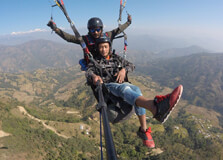
Paragliding in Nagarkot, Nepal, offers a thrilling and scenic adventure for travelers seeking an adrenaline rush combined with breathtaking views of the Himalayas. Nestled just a short drive from Kathmandu, Nagarkot is a serene hill station famous for its panoramic sunrise views over the mountains. In recent years, it has become a popular destination for paragliding enthusiasts due to its ideal take-off points, clear skies, and spectacular vistas of the snow-capped peaks and lush valleys below. Whether you are a beginner or a seasoned flyer, paragliding in Nagarkot provides an unforgettable experience soaring above beautiful landscapes. How to Reach Paragliding in Nagarkot, Nagarkot Nagarkot is located about 30 kilometers east of Kathmandu, and getting there is relatively easy: By Car or Taxi: The most convenient way is to hire a private taxi or car from Kathmandu. The drive takes around 1.5 to 2 hours and passes through Bhaktapur, a historic city. By Bus: Public buses and microbuses leave from the Kathmandu Bus Park or from Bhaktapur to Nagarkot. The journey may take a bit longer due to stops but is budget-friendly. By Tour Operator: Many paragliding service providers offer pick-up and drop-off services from Kathmandu or nearby hotels in Nagarkot. This is the most hassle-free option. Weather in Nagarkot for Paragliding Weather plays a crucial role in paragliding safety and enjoyment. Nagarkot enjoys a mild climate throughout the year, making it a great location for paragliding. Spring (March to May): Ideal for paragliding with clear skies, stable winds, and pleasant temperatures ranging between 15°C and 25°C. Autumn (September to November): The best season for paragliding. Skies are clear, winds are calm, and the Himalayan views are stunning. Winter (December to February): Good visibility but colder temperatures. Still suitable for flying, though layering up is recommended. Monsoon (June to August): Not ideal due to heavy rain, strong winds, and poor visibility. Most operators do not conduct flights during this season. Timings for Paragliding in Nagarkot Paragliding flights in Nagarkot typically run during daylight hours when weather conditions are favorable. Flight Hours: Between 9:00 AM to 3:30 PM. Morning flights are usually calmer and provide better conditions for first-time flyers. Duration: A typical tandem flight lasts 20 to 30 minutes depending on wind conditions and the package chosen. Best Time to Fly: Early mornings are ideal due to calm winds and excellent visibility of the Himalayas. Why Famous for Paragliding in Nagarkot, Nagarkot? Paragliding in Nagarkot has gained popularity for several reasons: Incredible Views: From the air, flyers can enjoy spectacular views of the Langtang range, Mount Everest (on clear days), terraced farmlands, lush forests, and traditional villages. Perfect Altitude: Nagarkot is situated at around 2,200 meters above sea level, providing the ideal altitude for safe and exciting paragliding experiences. Easy Accessibility: Its proximity to Kathmandu makes it an easy day trip for adventure seekers. Peaceful Setting: Unlike busier paragliding spots, Nagarkot offers a tranquil environment for a relaxed yet thrilling flight. Entry and Visit Details for Paragliding in Nagarkot Paragliding in Nagarkot is organized by several professional companies that ensure safety and provide all necessary equipment. Cost: Tandem flights (with an instructor) typically cost between NPR 8,000 to NPR 12,000 (approx. USD 60 to 100), depending on the duration and whether photos/videos are included. Booking: It’s recommended to book your flight a day in advance. Many local hotels can help you with bookings or you can contact tour operators directly. Age and Weight Restrictions: Generally, participants must be at least 14 years old and weigh between 35 kg to 100 kg. Consult with operators for exceptions. Gear Provided: The service includes helmets, harnesses, and safety equipment. You just need to wear comfortable clothes and shoes. History and Development of Paragliding in Nagarkot Paragliding in Nepal started gaining traction in the early 2000s, with Pokhara leading the adventure tourism trend. However, as tourism spread to Nagarkot, paragliding operators recognized its potential due to its high altitude, steady thermals, and panoramic views. Over the years, operators have developed safe launch sites and training programs, making Nagarkot a top location for paragliding in central Nepal. Things to Do Near Paragliding in Nagarkot Besides paragliding, there are plenty of activities to enjoy in and around Nagarkot: Hiking: Nagarkot is known for scenic hiking trails like the Nagarkot Panoramic Hiking Trail and nature walks through forested paths and villages. View Tower: The Nagarkot View Tower offers 360-degree views of the Himalayas, perfect for photography and sunrise/sunset watching. Mountain Biking: Adventurous travelers can rent a bike and ride through the hilly trails of Nagarkot. Cultural Visits: Explore local villages, visit temples, and interact with the friendly Tamang communities in the area. Facts About Paragliding in Nagarkot Nagarkot is one of the few places in the world where you can paraglide with views of Mount Everest in the distance (weather permitting). All tandem flights are conducted by certified and experienced pilots, ensuring maximum safety. Paragliding companies offer video and photo packages so you can capture your flight memories. The takeoff site is usually located near the Nagarkot View Tower, which is accessible by vehicle. Flights are subject to weather clearance, and sometimes last-minute cancellations may occur for safety reasons. Tips for Paragliding in Nagarkot Wear Comfortable Clothes: Opt for warm layers, especially during the winter, and closed-toe shoes with good grip. Check the Weather: Book your flight on a clear day for the best views and safer conditions. Book in Advance: Though walk-ins are welcome, booking a day prior helps secure your spot and plan your trip better. Hydrate and Eat Light: Avoid heavy meals before flying, but do stay hydrated. Some people may experience mild motion sickness. Be Honest with the Pilot: Inform your pilot if you have any health concerns or fears. They can adjust the flight accordingly to ensure your comfort.
Explore More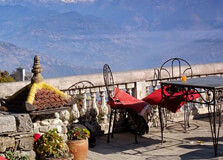
Nagarkot Nature Trail is a scenic and peaceful walking route located in the hill station of Nagarkot, Nepal. It is a perfect destination for nature lovers, hikers, and travelers who want to explore the beauty of Nepalese countryside without engaging in challenging treks. The trail offers panoramic views of the Himalayan ranges, lush green forests, terraced farmlands, and traditional villages. It’s a serene escape from the busy life of Kathmandu and a great way to immerse yourself in Nepal’s natural charm. How to Reach Nagarkot Nature Trail, Nagarkot Nagarkot is easily accessible from Kathmandu and nearby towns: By Car/Taxi: The most convenient way is to take a private taxi or car from Kathmandu, which is around 30 kilometers away. The drive takes about 1.5 to 2 hours depending on traffic. By Bus: Local buses run from Kathmandu to Bhaktapur, and from there you can catch another bus or jeep to Nagarkot. By Tour Operator: Many local travel companies offer guided hiking tours and transportation packages to the Nagarkot Nature Trail. Once you reach Nagarkot, the trail begins near the Nagarkot Bus Stop or close to the Nagarkot View Tower, depending on the specific route you choose. Weather in Nagarkot Nature Trail, Nagarkot Nagarkot has a pleasant and temperate climate throughout the year, making it suitable for outdoor activities: Spring (March to May): Mild temperatures with blooming flowers and clear skies, ideal for hiking. Summer/Monsoon (June to August): Green and fresh scenery, but heavy rains and leeches can make hiking difficult. Autumn (September to November): The best season with cool weather, clear skies, and excellent mountain views. Winter (December to February): Chilly mornings and evenings but perfect for clear skies and snow-capped mountain views. Average temperatures range from 5°C in winter to 25°C in summer. Timing for Nagarkot Nature Trail Trail Hours: Open all day, but it’s best to hike between 6:00 AM and 4:00 PM to avoid walking after dark. Ideal Duration: Most hikers complete the trail in 2 to 4 hours, depending on the pace and rest stops. Best Time to Visit: Early morning is perfect for sunrise views and birdwatching. Why Famous for Nagarkot Nature Trail, Nagarkot? The Nagarkot Nature Trail is famous for offering stunning views of the Himalayas, including peaks like Mt. Everest on a clear day. It provides an easy and accessible way to enjoy nature, local culture, and panoramic landscapes without going on long treks. It's particularly popular among tourists who want a taste of Nepal’s natural beauty in just a few hours. Entry and Visit Details for Nagarkot Nature Trail Entry Fee: There is no specific entry fee for the nature trail, but a small environmental or tourism fee may be charged at some checkpoints (usually around NPR 100 for foreigners). Guide Services: Available through local hotels or tour agencies, though not mandatory. Helpful for first-time visitors or those interested in local flora and fauna. Trail Condition: Well-marked paths, mostly easy to moderate difficulty, suitable for all age groups. Facilities: Local tea houses and shops are available along the trail for refreshments. History and Architecture of Nagarkot Nature Trail While the Nagarkot Nature Trail doesn’t have architectural monuments along its path, it plays a significant role in the eco-tourism of the area. Historically, Nagarkot was a strategic location for ancient Malla kings to monitor approaching enemies. Over time, it developed into a popular retreat for city dwellers and tourists. The trail highlights traditional Nepalese architecture in local homes and village temples, offering a peek into rural life. The natural trail was developed with an aim to promote sustainable tourism and preserve the ecological richness of the region. Things to Do on the Nagarkot Nature Trail Hiking: The primary activity. Enjoy a peaceful walk through forests, farmlands, and ridges with views of the Himalayas. Photography: Ideal for landscape, sunrise, and village life photography. Birdwatching: Spot native birds and wildlife, especially in the early morning. Village Visits: Interact with locals and see traditional farming practices in nearby Tamang and Newar villages. Sunrise and Sunset Views: Watch the sky turn golden behind mountain peaks from viewpoints along the trail. Facts About Nagarkot Nature Trail The trail is around 3.5 to 5 kilometers long, depending on the specific route taken. Views of 8 out of the 13 Himalayan ranges in Nepal can be seen from Nagarkot. There are several trail options, including the Nagarkot Eco Trail and the Nagarkot Panoramic Hiking Trail. Nagarkot is at an altitude of about 2,200 meters (7,200 ft), making it cool and refreshing even in summer. Local community efforts have helped maintain and clean the trail to promote sustainable tourism. Tips for Visiting Nagarkot Nature Trail Wear Comfortable Shoes: Choose good hiking or walking shoes with grip, as the trail may have uneven sections. Start Early: Morning hikes offer cooler weather, fewer crowds, and better views. Carry Water and Snacks: Though tea houses are available, it’s best to stay hydrated and carry light snacks. Respect Local Culture: When passing through villages, be polite and ask for permission before taking photos of people. Check the Weather: Clear weather gives the best mountain views. Avoid rainy days when the trail may be slippery. Use Sunscreen and a Hat: The sun can be strong at high altitudes even if the weather is cool.
Explore More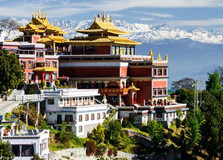
Nagarkot Panoramic Hiking Trail
Nagarkot Panoramic Hiking Trail is a beautiful hiking route located in Nagarkot, a famous hill station near Kathmandu, Nepal. This trail offers breathtaking views of the Himalayas, rolling hills, dense forests, and traditional Nepalese villages. It's a relatively easy to moderate trail that is suitable for beginners, families, and even experienced hikers looking for a short, scenic adventure. This trail is one of the best ways to enjoy Nepal's natural beauty without going on a long trek. How to Reach Nagarkot Panoramic Hiking Trail, Nagarkot Nagarkot is located about 30 kilometers east of Kathmandu. Here are the common ways to reach the hiking trail: By Car/Taxi: The fastest way is by taxi or private vehicle from Kathmandu. The drive takes about 1.5 to 2 hours depending on traffic. By Bus: Take a local bus from Kathmandu to Bhaktapur. From Bhaktapur, catch another bus or jeep to Nagarkot. By Tour Package: Many travel agencies offer hiking packages that include transportation, guide services, and meals. Once in Nagarkot, the trail usually starts near the Nagarkot Bus Station or View Tower area. Weather in Nagarkot Panoramic Hiking Trail, Nagarkot Nagarkot has a cool and pleasant climate most of the year. The weather is one of the highlights of the trail: Spring (March to May): Mild and comfortable weather, with blooming rhododendrons and wildflowers. Summer/Monsoon (June to August): Lush greenery and misty views, but also frequent rain and slippery trails. Autumn (September to November): Best time for hiking, with clear skies, fresh air, and fantastic mountain views. Winter (December to February): Cold mornings and evenings, but clear skies offer some of the best Himalayan visibility. Temperatures can range from 5°C in winter to 25°C in summer. Timing for Nagarkot Panoramic Hiking Trail Trail Hours: The trail is open all day, but it's recommended to start between 6:00 AM and 10:00 AM. Best Time to Visit: Early morning hikes allow you to witness sunrise and avoid strong midday sun. Duration: The hike usually takes 3 to 4 hours to complete, depending on your pace and stops. Why Famous for Nagarkot Panoramic Hiking Trail, Nagarkot? This trail is famous for its stunning 360-degree views of the Himalayan mountain ranges, including peaks like Mount Everest (on clear days), Ganesh Himal, Langtang, and Manaslu. Hikers also enjoy passing through thick pine forests, peaceful villages, and terraced farms. It is the perfect blend of nature, culture, and physical activity all in one short day hike. Entry and Visit Details for Nagarkot Panoramic Hiking Trail Entry Fee: There may be a small entry fee of around NPR 100–200 for foreign tourists, usually collected at the Nagarkot entrance gate or view tower. Opening Hours: Open daily from sunrise to sunset. No specific opening hours as it is a public trail. Guide: Not required but recommended if you want more insights about the flora, fauna, and local lifestyle. Facilities: Rest areas, small tea shops, and restrooms are available along the trail. History and Architecture of Nagarkot Panoramic Hiking Trail While the trail itself is not an architectural site, it provides glimpses of the traditional architecture of Nepalese mountain villages. You'll walk through hamlets where homes are built in typical Newari or Tamang style using stone and mud, with thatched or tin roofs. Nagarkot used to serve as a fort to monitor external activities in ancient times during the Malla period. The hiking trail is a modern addition aimed at promoting eco-tourism and local employment through sustainable tourism. Things to Do on the Nagarkot Panoramic Hiking Trail Hiking: The main activity is hiking through a variety of landscapes and natural environments. Mountain Viewing: Stop at scenic spots for spectacular views of the snow-capped Himalayas. Photography: Excellent opportunities for sunrise, mountain, and landscape photography. Visit Villages: Interact with locals in villages like Rohini and Kattike, and learn about their traditional lifestyle. Birdwatching: The trail is home to many bird species, especially during early mornings. Picnicking: Bring snacks or lunch and rest at a viewpoint surrounded by nature. Facts About Nagarkot Panoramic Hiking Trail The total trail length is about 12 kilometers and forms a loop. It is located at an altitude of approximately 2,175 meters above sea level. You can see 8 out of 13 Himalayan ranges in Nepal from Nagarkot on a clear day. The trail is relatively safe and suitable for solo travelers and families. The path is marked, and signboards are available along the route for guidance. Tips for Visiting Nagarkot Panoramic Hiking Trail Wear Good Shoes: Choose proper hiking shoes as the trail can be uneven and rocky in some areas. Carry Water and Snacks: Stay hydrated and energized, especially if you’re not planning to stop at tea shops. Dress in Layers: Mornings and evenings can be chilly while afternoons are warmer. Bring a Map or Use GPS: Although the trail is marked, having a basic map or offline GPS app helps. Start Early: Enjoy peaceful surroundings, avoid heat, and get the best light for photography. Protect Against Sun: Carry sunscreen, sunglasses, and a hat for sunny days. Support Local Businesses: Buy tea or snacks from local shops along the trail to support the community.
Explore More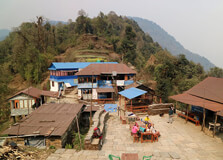
Deurali Hill, located in the Arghakhanchi district of Nepal, is a serene and scenic destination known for its breathtaking views, spiritual ambiance, and cultural importance. Nestled in the western hills of Nepal, Deurali Hill is a hidden gem that offers panoramic views of rolling green hills, deep valleys, and distant snow-capped Himalayan peaks. It is also home to the famous Supa Deurali Temple, which makes the area a prominent pilgrimage site. Ideal for nature lovers, spiritual seekers, and adventure enthusiasts, Deurali Hill is an excellent spot for hiking, meditation, and photography. How to Reach Deurali Hill, Deurali Reaching Deurali Hill involves a scenic journey through the hills of western Nepal. The nearest town is Sandhikharka, the district headquarters of Arghakhanchi. From there, travelers can continue toward Deurali by road. From Kathmandu: You can take a local bus or private vehicle to Butwal or directly to Sandhikharka. From Sandhikharka, local jeeps and buses are available to reach Deurali. The entire journey may take about 10–12 hours depending on road conditions. From Butwal: Deurali is around 100 km from Butwal and takes about 4–5 hours to reach by vehicle. From Pokhara: It takes approximately 7–8 hours via road. You can take a bus or hire a private jeep for a more comfortable journey. The last stretch of the road leading up to Deurali Hill may require a short hike, adding a touch of adventure to the visit. Weather in Deurali Hill Deurali Hill enjoys a moderate climate with distinct seasonal changes: Spring (March to May): The best time to visit. The weather is pleasant, skies are mostly clear, and rhododendrons bloom in the region. Monsoon (June to August): The area receives significant rainfall. The trails may be slippery, and visibility is low due to clouds and fog. Autumn (September to November): Another ideal time to visit. The skies are clear, offering excellent views of the surrounding mountains and forests. Winter (December to February): Cold temperatures prevail, and the area may experience light snowfall, especially in January. Carry warm clothes if visiting during winter. Timings for Visiting Deurali Hill There are no specific entry timings or restrictions for visiting Deurali Hill. However, it's best to visit during daylight hours, ideally between: Morning: 6:00 AM to 11:00 AM Afternoon: 2:00 PM to 5:30 PM It’s advisable to avoid evening or night visits, especially if you're hiking or unfamiliar with the terrain. Why is Deurali Hill Famous? Deurali Hill is famous for multiple reasons. Its natural beauty makes it a popular spot for panoramic views of the surrounding landscape. Additionally, the presence of Supa Deurali Temple, a revered site among Hindu devotees, adds spiritual significance to the hill. Many pilgrims visit the temple believing that the goddess fulfills wishes and provides protection during travels. The hill is also known for its peaceful environment, making it ideal for yoga, meditation, and personal retreats. Entry and Visit Details There is no entry fee to visit Deurali Hill. Visitors are welcome to explore the area freely. During festivals like Dashain, Tihar, and especially local celebrations associated with Supa Deurali Temple, the hill can become crowded, and local authorities may assist in managing pilgrims. Basic facilities such as water, snacks, and toilets are available at nearby settlements, but it is recommended to carry your essentials. History and Cultural Importance The history of Deurali Hill is deeply intertwined with local folklore and religious practices. The hill has been a place of worship and pilgrimage for generations. The Supa Deurali Temple, located near the hilltop, is believed to have miraculous powers. Stories passed down orally speak of the goddess protecting travelers and granting wishes. Historically, the hill has served as a lookout point due to its elevation, and even now, it remains an important cultural landmark in the Arghakhanchi district. Architecture and Natural Landscape While Deurali Hill itself is a natural formation, the Supa Deurali Temple on its slope is built in the traditional Nepali pagoda style, with wooden carvings and stone steps. The natural landscape is characterized by dense green forests, rocky terrain, and open grasslands that offer ideal spots for picnics and viewing platforms. Things to Do at Deurali Hill Visit Supa Deurali Temple: Participate in prayers, light butter lamps, and offer flowers to the goddess. Hiking and Nature Walks: Explore nearby trails that offer amazing views and rich biodiversity. Photography: Capture the sunrise, sunset, and panoramic vistas of hills and villages. Bird Watching: Spot local birds and wildlife in the forested regions around the hill. Meditation and Yoga: Enjoy the peaceful environment, perfect for inner reflection and relaxation. Facts About Deurali Hill Deurali Hill sits at an elevation of approximately 2,000 meters above sea level. The hill is named after “Deurali,” which in Nepali refers to a pass or high point between mountains. It is both a religious site and a trekking destination, attracting pilgrims and adventure lovers alike. The hill is surrounded by small villages that preserve local culture and traditions. During major Hindu festivals, thousands of devotees flock to the area for spiritual rituals. Tips for Visiting Deurali Hill Wear comfortable trekking shoes, especially if you plan to hike to the top. Carry water, snacks, and a light jacket, especially in cooler months. Visit during spring or autumn for the best weather and clear views. Respect local customs and avoid littering in the natural areas. If possible, travel with a local guide or someone familiar with the area for a more informative experience. Start early in the morning to enjoy sunrise views and avoid afternoon clouds. Conclusion Deurali Hill in Deurali is a place of natural beauty, spiritual depth, and cultural heritage. Whether you're a pilgrim seeking blessings, a hiker looking for breathtaking views, or a traveler wanting to connect with local traditions, Deurali Hill offers an unforgettable experience. Surrounded by tranquil forests, historical significance, and friendly local communities, this destination is a peaceful escape into nature and faith.
Explore More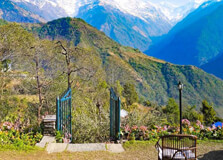
Ghorepani Poon Hill is one of the most popular trekking destinations in Nepal, located in the Annapurna region. It offers a short yet incredibly scenic trek that rewards visitors with stunning sunrise views over the snow-capped peaks of the Annapurna and Dhaulagiri ranges. The trail passes through beautiful rhododendron forests, traditional villages, and terraced hillsides, making it a favorite among beginners and experienced trekkers alike. While the hill itself is near the village of Ghorepani, the Deurali section of the trail is one of the peaceful and scenic resting points before reaching Poon Hill. How to Reach Ghorepani Poon Hill, Deurali To reach Ghorepani Poon Hill, travelers generally start their journey from the beautiful city of Pokhara, which is well connected to Kathmandu and other cities by air and road. Here’s how you can reach the trek starting point: From Pokhara to Nayapul: Take a taxi, jeep, or local bus to Nayapul, which is around 42 km and takes about 1.5 to 2 hours. Nayapul to Ghorepani: Begin the trek from Nayapul. It takes about 2–3 days to reach Ghorepani depending on your pace and overnight stays. Deurali on the trail: Deurali lies en route and is a great place to rest or stay overnight. Many trekkers choose to stop at Deurali due to its quiet setting and stunning views. Porters and guides are available in Pokhara for hire, which is recommended if you are new to trekking or carrying heavy loads. Weather at Ghorepani Poon Hill The weather at Ghorepani Poon Hill varies according to season, and the best time to visit is: Spring (March–May): Clear skies, blooming rhododendrons, and moderate temperatures make this the best season for trekking. Autumn (September–November): Also ideal for trekking, with crisp air and spectacular mountain views. Winter (December–February): Very cold and sometimes snowy, but also less crowded and perfect for those prepared for cold conditions. Monsoon (June–August): Not recommended due to heavy rains, leeches, and muddy trails. Views are often obscured by clouds. Timings for Visiting Ghorepani Poon Hill The best time of day to visit Poon Hill is early morning—between 4:30 AM and 6:30 AM—to watch the breathtaking sunrise over the Himalayas. Trekkers usually begin the final ascent from Ghorepani village at around 4:00 AM, reaching the summit just in time for sunrise. For trekking, it's best to start each day's hike by 7:00 AM to avoid the afternoon heat or possible cloud cover. Why is Ghorepani Poon Hill Famous? Poon Hill is famous for offering one of the most rewarding views of the Annapurna and Dhaulagiri mountain ranges without requiring a long or difficult trek. The sunrise from Poon Hill is a magical experience, as the golden light touches the snow-covered peaks, including Annapurna South, Machhapuchhre (Fishtail), Dhaulagiri, and Nilgiri. It is also known for its rich cultural experience, as the trail passes through Magar and Gurung villages. Entry and Visit Details Trekkers need to obtain the following permits before starting the trek: TIMS Card (Trekkers’ Information Management System): Required for all trekkers, costs approximately NPR 2,000 for international visitors. ACAP Permit (Annapurna Conservation Area Permit): Costs around NPR 3,000 for foreigners and is mandatory for conservation purposes. Permits can be obtained in Pokhara or Kathmandu. It is advisable to carry passport-sized photos and your passport when applying. History and Architecture Ghorepani and Deurali are traditional Magar villages, rich in history and culture. While there are no grand architectural monuments, the region’s charm lies in its traditional stone houses, slate roofs, and age-old footpaths built by locals. The trail itself has been used by shepherds, traders, and pilgrims for centuries, making it culturally significant. The word "Ghorepani" translates to "horse water" in Nepali, as it was a traditional resting spot for traders and their horses in the past. Things to Do at Ghorepani Poon Hill Hiking and Trekking: Enjoy moderate-level trekking with fantastic mountain views and forest paths. Sunrise View: Watch the unforgettable sunrise over the Himalayas from Poon Hill. Photography: Capture spectacular landscapes, terraced fields, local life, and mountain views. Cultural Experience: Interact with locals in villages like Ghorepani, Tadapani, and Deurali and learn about Magar and Gurung cultures. Bird Watching and Nature Walks: Spot Himalayan birds and enjoy peaceful forest trails. Facts About Ghorepani Poon Hill Poon Hill stands at about 3,210 meters (10,531 feet) above sea level. Ghorepani village is located at around 2,874 meters. The trek is suitable for beginners and families. The entire round trip usually takes 4–5 days. The trail passes through Annapurna Conservation Area, one of the richest biodiversity zones in Nepal. Tips for Visiting Ghorepani Poon Hill Start early to catch the sunrise at Poon Hill. Carry layers of clothing as the weather changes quickly. Use a trekking pole and wear proper hiking boots. Stay hydrated and carry water purification tablets or a filter. Book teahouse accommodation in advance during peak season (March–May and October–November). Respect local customs and greet villagers with “Namaste.” Conclusion Ghorepani Poon Hill is a beautiful and memorable trek that combines natural beauty, cultural richness, and adventure in just a few days. Whether you're seeking the majestic Himalayan sunrise, quiet moments in the forested trails, or warm hospitality in mountain villages, this trek offers it all. Deurali, located along the trail, serves as a peaceful resting point and adds to the spiritual and natural charm of the journey. It’s a must-visit for anyone exploring Nepal.
Explore More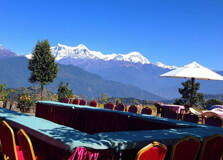
Himalayan Sunrise Point in Deurali is one of the most beautiful spots in the Annapurna region of Nepal. It is especially popular among trekkers and nature lovers for its stunning early morning views of the Himalayan mountains. From this viewpoint, travelers can see the golden rays of the sun gently lighting up snow-covered peaks like Annapurna, Machhapuchhre (Fishtail), Dhaulagiri, and Nilgiri. It is a peaceful and scenic place, perfect for watching sunrises, taking photos, and enjoying the calm of the mountains. How to Reach Himalayan Sunrise Point, Deurali Reaching the Himalayan Sunrise Point requires a bit of trekking, but the journey is worth it. Here's how you can get there: Step 1: Reach Pokhara Pokhara is the nearest major city and a common starting point. You can get to Pokhara from Kathmandu by flight (around 25 minutes) or by bus/car (6–8 hours). Step 2: Travel to Ghandruk or Nayapul From Pokhara, you can hire a jeep or take a local bus to Ghandruk or Nayapul, which takes about 2–3 hours. Step 3: Trek to Deurali From Ghandruk or Nayapul, you will start trekking. The trek can take 1–2 days depending on your starting point and pace. The trail is scenic, passing through forests, villages, and hills before reaching Deurali. It is recommended to go with a guide if you are not familiar with the trekking trails. Weather at Himalayan Sunrise Point, Deurali The weather in Deurali varies throughout the year: Spring (March to May): Mild and pleasant, perfect for trekking. Flowers bloom, and skies are usually clear. Summer (June to August): Monsoon season brings rain and fog. Trails can be slippery, and visibility is low. Autumn (September to November): Ideal time for visiting. The air is fresh, the sky is clear, and mountain views are the best. Winter (December to February): Cold with snow in higher areas. Mornings are freezing, but sunrises are beautiful and skies clear. Timing for Visiting Himalayan Sunrise Point The best time to visit Himalayan Sunrise Point is early in the morning before sunrise, usually between 4:30 AM and 6:30 AM. Visitors usually start their hike in the dark with headlamps or flashlights to reach the viewpoint in time. After 7 AM, the sun is already up, and you may miss the beautiful golden glow on the mountains. Why Famous for Himalayan Sunrise Point, Deurali? Himalayan Sunrise Point is famous for offering magical views of the Himalayan sunrise. When the sun rises behind the mountains and touches the peaks with golden light, it creates a magical and peaceful experience. This is one of the reasons why trekkers make it a point to include this stop in their journeys. It's also known for its peaceful surroundings, making it ideal for meditation, photography, and simply connecting with nature. Entry and Visit Details about Himalayan Sunrise Point, Deurali There are no direct entry tickets for the sunrise point itself, but since it lies within the Annapurna Conservation Area, you need the following permits: ACAP (Annapurna Conservation Area Permit): Costs NPR 3,000 for foreigners. TIMS (Trekkers’ Information Management System): Required for all trekkers, costs NPR 2,000. Both permits can be arranged in Kathmandu or Pokhara. You will need passport-size photos and a copy of your passport. Always carry these permits with you during the trek, as there are checkpoints along the way. History and Architecture Himalayan Sunrise Point does not have man-made architectural structures like temples or monuments. Instead, it is known for its natural beauty. However, the surrounding areas of Deurali and nearby villages showcase traditional Gurung and Magar architecture. Small stone houses with slate roofs and wooden balconies are common. Prayer flags often decorate the trail, adding a spiritual touch to the journey. Deurali also holds spiritual importance for many locals and trekkers. Some believe the place holds spiritual energy due to its height and peaceful environment. Things to Do at Himalayan Sunrise Point Watch the Sunrise: The main activity is waking up early to see the sunrise over the Himalayan mountains. Photography: Capture stunning images of snow-capped peaks glowing with morning light. Trekking: Continue trekking to Annapurna Base Camp, Ghorepani, or other nearby trails. Bird Watching: Spot Himalayan birds like the Danphe (national bird of Nepal). Relax and Meditate: Enjoy the quiet and calm of the mountains. It’s a great place for mental clarity and spiritual peace. Facts about Himalayan Sunrise Point Located at an elevation of over 3,000 meters above sea level. Offers views of several Himalayan peaks including Annapurna, Machhapuchhre, and Dhaulagiri. Part of the Annapurna Conservation Area, the largest protected area in Nepal. No major buildings, just nature and small viewpoints made of stones or wood. The place is most visited during October–November and March–April. Tips for Visiting Himalayan Sunrise Point, Deurali Start your hike early (around 4 AM) to reach the sunrise point in time. Carry a headlamp or flashlight for trekking in the dark. Wear warm clothes. Even in spring or autumn, mornings are cold. Carry water and light snacks. Use good trekking shoes, as the trail can be rocky and uneven. Respect local customs, avoid loud noise, and do not litter. If trekking in winter, check for snowfall or trail closures in advance. Conclusion Himalayan Sunrise Point in Deurali is a truly magical place in Nepal where nature reveals its most beautiful face. The quiet, the views, and the sense of peace make it a top destination for trekkers and travelers who want to experience the Himalayas in a special way. Whether you’re an adventurer or someone looking for inner peace, this viewpoint will stay in your memory forever.
Explore More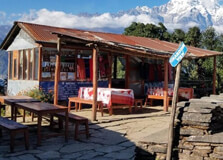
Deurali, located in the Annapurna region of Nepal, is a small but important stop for trekkers journeying through the Himalayas. It sits at an altitude of around 3,230 meters and is best known for its scenic trekking trails. The trekking trails in Deurali are part of the famous Annapurna Circuit and the Annapurna Base Camp (ABC) trek. These trails offer a perfect blend of adventure, natural beauty, and cultural experiences. Surrounded by lush forests, waterfalls, snow-covered peaks, and peaceful villages, the trekking trails around Deurali attract thousands of hikers from all over the world. How to Reach Trekking Trails, Deurali To reach the trekking trails in Deurali, you usually begin your journey from Pokhara, one of the major tourist cities in Nepal. Here’s a general route you can follow: Step 1: Kathmandu to Pokhara You can fly from Kathmandu to Pokhara in about 25 minutes or take a bus or private vehicle, which takes around 6–8 hours. Step 2: Pokhara to Nayapul or Jhinu Danda From Pokhara, take a jeep or bus to Nayapul or Jhinu Danda, depending on your chosen trekking route. The drive takes about 2–3 hours. Step 3: Begin Trekking From either Nayapul or Jhinu Danda, you begin trekking through various scenic villages like Ghandruk, Chhomrong, Himalaya, and finally reach Deurali. Depending on the pace, it takes about 3 to 4 days to reach Deurali from your starting point. The trails are well-marked, but hiring a local guide is always a safe and helpful option, especially if you are unfamiliar with the route. Weather in Deurali The weather in Deurali depends on the season and altitude. Since it is located above 3,000 meters, the climate is generally cool throughout the year. Spring (March to May): Mild temperatures and clear skies make it an excellent time to trek. The rhododendron forests are in full bloom. Monsoon (June to August): Heavy rain can cause landslides and slippery trails. Not recommended for trekking during this season. Autumn (September to November): The best season for trekking. Clear skies, mild weather, and fantastic mountain views. Winter (December to February): Very cold and snowy, but peaceful. You must be well-prepared with proper gear for winter trekking. Best Timing to Visit Trekking Trails, Deurali The best time to explore the trekking trails in Deurali is during the spring (March–May) and autumn (September–November) seasons. During these months, the weather is stable, and the visibility is excellent. The temperatures are comfortable for hiking, and you can enjoy clear views of the mountains. Try to start your trekking early in the morning each day to avoid strong afternoon sun or sudden weather changes. Early mornings also offer the best mountain views. Why Famous for Trekking Trails, Deurali? Deurali is famous because it lies on one of the most scenic and adventurous trekking routes in Nepal—the Annapurna Base Camp trek. Trekkers pass through Deurali on their way to Annapurna Sanctuary. It is also known for being close to the Machhapuchhre Base Camp (MBC), one of the most iconic spots in the region. The area is surrounded by towering cliffs, waterfalls, dense forests, and snow-capped peaks. The silence and natural beauty of Deurali make it a peaceful retreat for trekkers. It’s also a place where people can adjust to high altitudes before heading to higher camps. Entry and Visit Details To trek in the Deurali region and surrounding areas, you need the following permits: ACAP Permit (Annapurna Conservation Area Permit): NPR 3,000 for foreigners. TIMS Card (Trekkers' Information Management System): NPR 2,000 for individual trekkers. You can get both permits from the Nepal Tourism Board offices in Kathmandu or Pokhara. Make sure to carry passport-sized photos and your passport. Keep these permits with you during the trek as they are checked at multiple points. History and Architecture The trekking trails around Deurali have been used for centuries by local herders and traders. Over the years, these trails evolved into popular routes for tourists. Although there is not much man-made architecture in Deurali itself, the trail passes through traditional villages where you can see old stone houses and temples. The local Gurung and Magar communities in nearby villages have preserved their cultural heritage, visible in their traditional clothing, language, and way of life. Prayer flags, mani walls (stone walls with prayers), and small stupas are common along the trail. Things to Do on Trekking Trails, Deurali Trekking: Continue trekking to Machhapuchhre Base Camp or Annapurna Base Camp from Deurali. Photography: Capture dramatic landscapes, wildlife, and traditional villages. Bird Watching: Spot rare Himalayan birds and animals in the forested areas. Explore Nature: Enjoy waterfalls, forests, and mountain views. Interact with Locals: Learn about Gurung and Magar culture in nearby villages. Facts about Trekking Trails, Deurali Deurali is located at around 3,230 meters (10,597 feet) above sea level. Part of the Annapurna Conservation Area, the largest protected area in Nepal. The trail passes through forests of oak, bamboo, and rhododendrons. Common wildlife includes langurs, Himalayan thar, and various bird species. The region is considered sacred by locals, especially near Machhapuchhre Base Camp. Tips for Trekking Trails, Deurali Acclimatize properly to avoid altitude sickness—rest at Deurali if needed. Carry warm clothes even in spring and autumn, as temperatures drop at night. Wear good-quality trekking shoes with grip. Carry water and snacks, as shops are limited and spaced far apart. Use a trekking pole for balance and knee support on steep descents. Be mindful of weather forecasts—avoid trekking during storms or heavy snowfall. Leave no trash behind—carry reusable bottles and respect the environment. Conclusion Trekking Trails in Deurali offer one of the most rewarding experiences in the Himalayas. With beautiful natural surroundings, peaceful mountain villages, and well-marked trails, it is perfect for beginners and experienced trekkers alike. Whether you're heading to Annapurna Base Camp or simply enjoying a few days in nature, the journey through Deurali will leave you with unforgettable memories and a deep appreciation for Nepal’s mountains and culture.
Explore More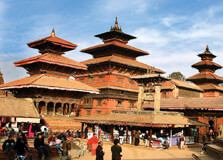
Patan Durbar Square, located in the heart of Lalitpur (also known as Patan), is one of the most famous and culturally significant historical landmarks in Nepal. The square is known for its rich history, stunning Newar architecture, and its position as a UNESCO World Heritage Site. Whether you're a history enthusiast, culture seeker, or someone who appreciates the beauty of ancient architecture, Patan Durbar Square is an unmissable destination in Nepal. Let's explore the key aspects of this iconic site. How to Reach Patan Durbar Square, Lalitpur Patan Durbar Square is located in the central part of Lalitpur, a short distance from Kathmandu, Nepal’s capital city. You can easily reach Patan Durbar Square by various modes of transport: By Taxi: Taxis are widely available throughout Kathmandu, and you can easily hire one to reach Patan. The ride takes around 15-30 minutes, depending on traffic. By Public Bus: Public buses are also available from Kathmandu to Patan. Bus routes run frequently, and it is an economical way to reach the square. By Private Vehicle: Renting a private vehicle for a more comfortable and hassle-free ride is another popular option for tourists. Walking: If you're staying in or near Kathmandu Durbar Square, you can walk to Patan Durbar Square, as it’s only about 3 to 4 kilometers away. Weather and Timing The weather in Lalitpur (Patan) is typically mild and pleasant, making it a great destination to visit year-round. However, here’s a brief overview of what to expect: Spring (March to May): The temperature is moderate, and it’s a great time to visit as the flowers are in bloom. Summer (June to August): This season sees warmer temperatures and occasional rainfall. It's still a good time to visit, though you should carry an umbrella or raincoat. Autumn (September to November): Autumn offers cooler weather with clear skies, making it the most popular time to visit Patan Durbar Square. Winter (December to February): The weather is cooler, but the temperatures remain moderate, ideal for exploring outdoor sites without too much heat. Patan Durbar Square is open daily, and visitors can explore the square during daylight hours. It is recommended to visit in the morning or late afternoon to avoid the midday heat and enjoy the beauty of the square when it is less crowded. Why Famous for Patan Durbar Square, Lalitpur? Patan Durbar Square is famous for its historical significance and exceptional Newar architecture. As the former royal palace of the Malla Kings, it was once the seat of power in the Kathmandu Valley. It is also an important religious site, with numerous Hindu temples, Buddhist stupas, and shrines scattered throughout the square. Here are a few key reasons why Patan Durbar Square is famous: Architectural Marvel: The square is a treasure trove of well-preserved Newar-style architecture, including intricately carved wooden windows, elaborate stonework, and pagoda-style temples. The structures showcase the advanced craftsmanship of the time and are a testament to the artistic and cultural heritage of Nepal. UNESCO World Heritage Site: Patan Durbar Square is recognized as a UNESCO World Heritage Site due to its historical and architectural significance. Patan Museum: Located within the Durbar Square, the Patan Museum houses an extensive collection of religious art and artifacts from the medieval era. It is one of the finest museums in Nepal. Spiritual Hub: The square is home to several important Hindu and Buddhist temples, including the Mahabouddha Temple, Hiranya Varna Mahavihar (Golden Temple), and the Keshav Narayan Chowk. Entry and Visit Details about Patan Durbar Square, Lalitpur To visit Patan Durbar Square, there is a nominal entry fee for foreign visitors, while Nepali citizens can visit free of charge. The entry fee is collected at the entrance of the square, and the funds go towards the conservation and maintenance of the historic site. As of the last updates, the entry fee for foreign tourists is around NPR 1,000 (approximately 10 USD), and the fee for students is usually discounted. Visitors can explore the square at their own pace, and guides are available for hire if you want a more in-depth understanding of the history and significance of each temple and structure. The square is a great place to wander, take photographs, and enjoy the local atmosphere. History and Architecture of Patan Durbar Square Patan Durbar Square was built during the Malla period, and the structures in the square date back to the 17th and 18th centuries. The palace complex was the residence of the Malla kings and served as the political and cultural center of the region. The intricate wood carvings and sculptures seen throughout the square reflect the artistic legacy of the Malla dynasty. The architecture of Patan Durbar Square is an excellent example of Newar craftsmanship, with delicate woodwork, intricately carved windows, and towering pagoda-style temples. The major temples and structures here include: Mahabouddha Temple: Known for its terracotta sculptures of Buddha, this temple is one of the most distinctive in the square. Hiranya Varna Mahavihar (Golden Temple): A beautiful Buddhist monastery known for its golden exterior and intricate designs. Patan Royal Palace: The former residence of the Malla kings, the palace features a stunning courtyard and traditional architecture. Rudra Varna Mahavihar: A temple dedicated to Lord Shiva, this structure is known for its beautiful sculptures and religious significance. Things to Do in Patan Durbar Square There are plenty of things to see and do while visiting Patan Durbar Square: Explore Temples: Visit the many Hindu and Buddhist temples, each with its unique history and architectural beauty. Visit the Patan Museum: Spend time in the museum to explore the vast collection of ancient artifacts, art, and religious items. Photography: The square is a photographer's dream, with stunning views of temples, courtyards, and busy streets. Enjoy Local Crafts: The area around the square is filled with shops selling traditional Newar crafts, from wood carvings to intricate jewelry. Facts and Tips about Patan Durbar Square, Lalitpur Tip 1: Wear comfortable shoes, as there is a lot of walking around the square and its surroundings. Tip 2: Visit early in the morning or later in the afternoon to avoid the crowds and the midday heat. Fact 1: Patan Durbar Square was severely damaged in the 2015 earthquake, but many of the structures have been successfully restored. Fact 2: The square is not only a historical site but also a place of daily life, with locals going about their routines amidst the temples and monuments. Tip 3: Hire a local guide for a deeper understanding of the cultural and historical significance of the square. Conclusion Patan Durbar Square is a must-visit destination for anyone exploring Lalitpur or Kathmandu. With its impressive history, beautiful temples, and vibrant culture, it offers an unforgettable experience. Whether you're admiring the intricate carvings on the temples, learning about Nepal's rich history, or simply soaking in the atmosphere, Patan Durbar Square is a treasure trove of cultural and architectural marvels that will leave you in awe.
Explore MoreKathmandu - Nepalgunj - Bardia National Park Tour
4 Days/ 3 Night
Kathmandu - Nepalgunj
Travel Agents In Gorakhpur
5 Days/ 4 Night
Lumbini - Kathmandu - Pokhara
Nepal Surface Package
8 Days/ 7 Night
Kathmandu - Chitwan - Pokhara
5 Night 6 Days Package For Kathmandu - Pokhara
6 Days/ 5 Night
Kathmandu - Pokhara
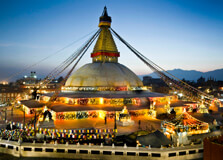
Buddhanath Stupa in Lalitpur is a serene and culturally rich Buddhist monument that reflects Nepal’s deep spiritual traditions and heritage. Often overshadowed by the more famous Boudhanath Stupa in Kathmandu, Buddhanath Stupa in Lalitpur remains a quiet, sacred site for local devotees and visiting tourists who seek a peaceful atmosphere for reflection, prayer, and exploration. Surrounded by a mix of monastic buildings, prayer flags, and local homes, this stupa represents centuries of Buddhist practice, particularly from the Newar and Tibetan Buddhist communities. How to Reach Buddhanath Stupa, Lalitpur Reaching Buddhanath Stupa in Lalitpur is convenient and accessible due to the city’s well-connected roads and public transportation. From Kathmandu: The stupa is about 7-10 km from central Kathmandu. You can take a local bus, microbus, or hire a taxi directly to Lalitpur. The journey usually takes around 30–45 minutes depending on traffic. Local Access: Within Lalitpur, you can easily walk or take a rickshaw or taxi to the site. Many locals know the stupa and can guide you if needed. Weather Lalitpur has a temperate climate that allows year-round visits to Buddhanath Stupa. Here’s what to expect in different seasons: Spring (March–May): Pleasant and mild temperatures with blooming flowers and festivals. Ideal for walking and sightseeing. Monsoon (June–August): Heavy rainfall can occur. It’s recommended to carry umbrellas and raincoats. The stupa looks especially beautiful in the rain with prayer flags fluttering in the wind. Autumn (September–November): Clear skies, moderate temperatures, and festive vibes make this the best time to visit. Winter (December–February): Cool but not freezing. A calm and peaceful time to experience the stupa with fewer crowds. Timing The stupa is generally open all day, from early morning till evening, and there is no strict closing time as it is in an open area. However, the best time to visit is during daylight hours. Opening Hours: Typically from sunrise (~6:00 AM) to sunset (~6:00 PM) Best Time to Visit: Early morning or just before sunset for a tranquil experience Why Famous for Buddhanath Stupa, Lalitpur? Buddhanath Stupa is famous for being a significant Buddhist shrine that caters to the local community's spiritual needs. Unlike the more touristic stupas, this stupa is appreciated for its peaceful surroundings and authentic ambiance. Spiritual Hub: A peaceful destination for local and visiting Buddhists for meditation and prayer. Cultural Harmony: Represents the shared spiritual culture between Tibetan Buddhism and Newar Buddhism in the Kathmandu Valley. Symbolic Design: The stupa’s eyes of Buddha and dome structure hold deep symbolic meaning in Buddhist philosophy. Entry and Visit Details about Buddhanath Stupa, Lalitpur Entry Fee: Free for all visitors Best Time to Visit: Early morning or late afternoon for spiritual ambiance and photography Accessibility: Easily accessible by road; walking is recommended for nearby travelers Etiquette: Walk clockwise around the stupa, do not climb on the structure, and respect people meditating or praying History and Architecture While not as ancient or large as Boudhanath in Kathmandu, Buddhanath Stupa in Lalitpur has its own history tied to the development of Buddhism in the valley. It was likely built by local Newar Buddhists and has been maintained over centuries by the community and monks. The stupa serves as a smaller but significant replica of larger Buddhist monuments in Nepal. Architecturally, the stupa follows traditional Buddhist design. It features a large white dome representing the earth, with a square structure on top painted with Buddha’s all-seeing eyes. Above this is a spire symbolizing the path to enlightenment, crowned with a gilded pinnacle. Surrounding the stupa are prayer wheels, small shrines, and walls lined with mani stones and Tibetan scripts. Things to Do at Buddhanath Stupa, Lalitpur Stroll Around the Stupa: Walk the kora path around the stupa clockwise, spinning prayer wheels as a spiritual act. Meditation: Find a quiet corner to meditate or reflect in the peaceful atmosphere. Photography: Capture beautiful angles of the stupa, especially in the golden light of sunrise or sunset. Interact with Monks: Engage respectfully with monks or locals to learn about their spiritual practices. Visit Nearby Shops: Look for small stalls selling incense, Tibetan prayer items, and local handicrafts. Facts and Tips about Buddhanath Stupa, Lalitpur Fact: Though not as widely known as Boudhanath in Kathmandu, Buddhanath Stupa in Lalitpur is a respected religious center in the local community. Fact: The stupa is surrounded by traditional homes and monasteries, giving visitors an immersive cultural experience. Fact: Prayer wheels and Buddhist scriptures surround the stupa, making it a good spot for understanding Buddhist symbolism. Tip: Dress modestly and behave respectfully. Avoid loud behavior and never step on or climb the stupa. Tip: Bring a scarf or shawl for spiritual purposes if you plan to sit and meditate. Tip: If you’re visiting other Buddhist sites, this stupa can be part of a spiritual heritage walk through Lalitpur. Tip: Visit during morning chants or prayer sessions for a deeply moving experience. Conclusion Buddhanath Stupa in Lalitpur is a hidden gem in Nepal’s cultural and spiritual landscape. Its quiet charm, traditional architecture, and deep religious value offer a serene experience to anyone seeking peace, reflection, or a deeper understanding of Buddhism. Whether you’re a pilgrim, a tourist, or someone interested in Nepalese culture, a visit to this stupa provides both spiritual enrichment and a quiet break from the busy city life.
Explore More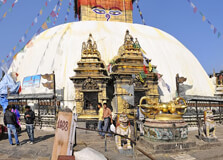
Swayambhunath Stupa, often referred to as the Monkey Temple due to the large population of monkeys residing in the area, is one of the oldest and most revered religious sites in Nepal. While the main Swayambhunath complex is located in Kathmandu, some people colloquially refer to smaller, locally revered stupas in Lalitpur with similar characteristics. This content will focus on the general spiritual, historical, and cultural importance of Swayambhunath, especially for visitors based in or coming through Lalitpur. How to Reach Swayambhunath Stupa, Lalitpur Though located in the Kathmandu district, Swayambhunath is easily accessible from Lalitpur (Patan), which is just a short drive away. By Taxi or Private Car: From the center of Lalitpur, it takes about 30–40 minutes to reach Swayambhunath Stupa. Taxis are available and convenient. By Public Bus: You can take a local bus from Lalitpur to Ratna Park and then transfer to a microbus heading toward Swayambhunath. By Bike or Scooter: For locals and tourists alike, biking is a popular and flexible option. Weather Swayambhunath Stupa can be visited throughout the year, and each season offers a unique experience: Spring (March to May): The weather is warm and ideal for sightseeing, with flowers blooming around the hill. Monsoon (June to August): It rains frequently, making the steps slippery, but the green surroundings are beautiful. Autumn (September to November): The best time to visit with clear skies, mild temperatures, and excellent visibility of the valley. Winter (December to February): The weather is cooler, especially in the early morning, but generally dry and suitable for hikes. Timing Swayambhunath is an open religious site, but certain areas, such as temples and shrines, have specific timings. Opening Hours: 5:00 AM to 7:00 PM Best Time to Visit: Early morning or late afternoon to avoid the heat and crowd Why Famous for Swayambhunath Stupa, Lalitpur? Swayambhunath is one of the most important and symbolic landmarks in Nepal. It is famous for: Spiritual Significance: It is a major pilgrimage site for both Buddhists and Hindus. Panoramic Views: Situated atop a hill, it offers a stunning view of Kathmandu Valley, visible from Lalitpur as well. Iconic Architecture: The all-seeing eyes of Buddha painted on the stupa are globally recognized. Cultural Coexistence: The site showcases the unique blend of Hinduism and Buddhism in Nepal. Entry and Visit Details about Swayambhunath Stupa, Lalitpur Entry Fee: NPR 200 for foreign nationals, free for locals Guides: Local guides are available for a small fee and offer insightful explanations Accessibility: There are two main approaches – a steep stairway with over 300 steps or a gradual road leading to the top Photography: Allowed and encouraged, but drones require special permission History and Architecture Swayambhunath is believed to have been built more than 2,500 years ago. Legend says that the Kathmandu Valley was once a lake, and a lotus flower grew at the center. The Bodhisattva Manjushri drained the lake, and the flower settled on a hill, which became the Swayambhunath Stupa. Architecturally, the stupa represents a mandala – a sacred geometric symbol. The white dome represents the earth, the golden spire symbolizes the 13 steps to enlightenment, and the all-seeing eyes represent wisdom and compassion. Smaller chaityas, shrines, and statues of Buddhist deities surround the central stupa, along with traditional prayer wheels and Tibetan-style prayer flags. Things to Do at Swayambhunath Stupa, Lalitpur Walk the Kora: Join pilgrims in walking clockwise around the stupa while spinning prayer wheels. Climb the Steps: Test your endurance by climbing the 365 steps leading directly to the stupa from the east. Enjoy Panoramic Views: Take in the sweeping views of Kathmandu Valley, especially stunning at sunrise and sunset. Feed the Monkeys: Monkeys are everywhere – friendly but curious. Feed them cautiously with fruit or peanuts. Visit the Monastery: Explore the adjacent monastery where monks chant and perform daily rituals. Photography: Capture the intricate details, from the stupa to the monkeys and religious art. Facts and Tips about Swayambhunath Stupa, Lalitpur Fact: The stupa is a UNESCO World Heritage Site and one of the oldest structures in Nepal. Fact: The name "Swayambhu" means "self-existent one." Fact: The site is equally respected by both Hindus and Buddhists, reflecting Nepal’s religious harmony. Tip: Wear comfortable walking shoes – the stairs can be steep and slippery, especially after rain. Tip: Carry water and sun protection during hotter months. Tip: Avoid teasing or feeding monkeys with plastic bags; they might snatch them aggressively. Tip: Dress modestly as this is a religious site. Cover shoulders and knees when possible. Tip: Visit early morning for meditation and chanting sessions or late evening to witness city lights from above. Conclusion Swayambhunath Stupa is not just a monument but a living, breathing symbol of Nepal’s spiritual soul. Whether you’re staying in Lalitpur or elsewhere in Kathmandu Valley, a visit to this sacred hill offers an unforgettable combination of history, faith, architecture, and scenic beauty. It stands as a testament to centuries of devotion and cultural richness that Nepal proudly preserves to this day.
Explore More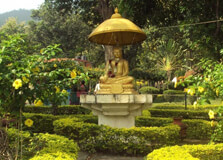
Manimukunda Sen Park, also known as Phulbari, is a historically significant and serene public park located in Butwal, Nepal. This park is renowned for its rich cultural heritage, lush greenery, and as the site of the ancient palace ruins of King Manimukunda Sen of the Palpa Kingdom. How to Reach Manimukunda Sen Park, Butwal The park is situated in the western part of Butwal city, approximately 300 meters west of the Tinau Bridge along the Mahendra Highway. Visitors can reach the park via: By Bus: Local buses and microbuses frequently operate routes that pass near the park. Alight at the Old Butwal Bus Park and take a short walk to the park entrance. By Taxi or Private Vehicle: Taxis and private vehicles can access the park directly, with parking facilities available nearby. By Foot or Bicycle: For those staying within Butwal, the park is accessible by walking or cycling, offering a pleasant journey through the city. Weather Butwal experiences a subtropical climate, characterized by: Spring (March to May): Warm and pleasant, ideal for outdoor activities. Summer (June to August): Hot and humid with heavy rainfall; visitors should be prepared for sudden showers. Autumn (September to November): Mild temperatures and clear skies, making it a popular time for tourism. Winter (December to February): Cool and dry, with temperatures ranging from 10°C to 20°C. Timing The park is open to visitors throughout the week: Opening Hours: 7:00 AM to 6:30 PM, Sunday to Saturday. Why Famous for Manimukunda Sen Park, Butwal? Manimukunda Sen Park holds significant historical and cultural importance due to: Historical Significance: It houses the ruins of the winter palace of King Manimukunda Sen, a prominent figure of the 16th-century Palpa Kingdom. Cultural Heritage: The park reflects the rich traditions and architectural styles of the Sen dynasty. Natural Beauty: The park's lush gardens and serene environment attract both locals and tourists seeking relaxation and recreation. Entry and Visit Details about Manimukunda Sen Park, Butwal Visitors are required to pay an entrance fee, which contributes to the maintenance and development of the park: Nepali Citizens: NPR 60 per visit. Students (with valid ID): NPR 40 per visit. SAARC Nationals: NPR 100 per visit. Foreign Nationals: NPR 200 per visit. Additional charges apply for certain activities such as cycling and amusement park rides. Discounts may be available for group visits and special events. History and Architecture Established in 1575 B.S. (1518 A.D.), the park was originally the site of King Manimukunda Sen's winter palace. The palace featured six grand rooms and served as a royal residence during the colder months. Over time, the palace fell into disrepair but was revitalized in the late 20th century by local authorities and conservation committees. Excavations have revealed a tunnel believed to connect the park to the historical site of Jeetgadhi, adding to its archaeological significance. Things to Do Manimukunda Sen Park offers a variety of activities for visitors: Explore Historical Ruins: Walk through the remnants of the ancient palace and learn about the Sen dynasty's history. Visit the Zoo: The park houses a small zoo featuring animals such as leopards, deer, and Nilgai. Enjoy the Gardens: Relax in the well-maintained gardens, ideal for picnics and leisurely strolls. Children's Playground: A designated area with slides and swings for children to enjoy. Photography: Capture the scenic beauty and historical structures within the park. Facts and Tips about Manimukunda Sen Park, Butwal Fact: The park spans approximately 16 bigahs of land and attracts over 800,000 visitors annually. Fact: It is managed by the Manimukunda Sen Udyan Conservation Committee, established to preserve its historical and cultural integrity. Tip: Visit during weekdays to avoid crowds and enjoy a more peaceful experience. Tip: Carry a valid ID to avail student discounts on entry fees. Tip: Wear comfortable footwear as the park covers a large area with various terrains. Tip: Respect the historical sites and avoid littering to help maintain the park's cleanliness and heritage.
Explore More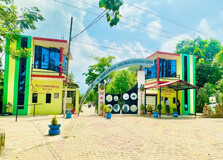
Shankarnagar Ban Bihar and Research Center
Shankarnagar Ban Bihar and Research Center, Butwal Shankarnagar Ban Bihar and Research Center, commonly referred to as Ban Batika, is a renowned eco-tourism destination situated in Tilottama Municipality, Rupandehi District, near Butwal, Nepal. Nestled within the Shankarnagar Community Forest, this center is celebrated for its rich biodiversity, serene environment, and commitment to conservation and research. It serves as a perfect retreat for nature enthusiasts, researchers, and families seeking a tranquil escape from urban life. How to Reach Shankarnagar Ban Bihar and Research Center, Butwal The center is conveniently located approximately 8 kilometers from the heart of Butwal city. Visitors can reach Ban Batika through various means: By Road: Regular local buses and taxis operate from Butwal to Tilottama Municipality. The journey takes about 20 minutes. By Private Vehicle: Visitors can drive via the Siddhartha Highway, following signs toward Shankarnagar. Adequate parking facilities are available on-site. By Air: The nearest airport is Gautam Buddha International Airport in Bhairahawa, approximately 25 kilometers away. From the airport, taxis and buses are available to reach the center. Weather Shankarnagar experiences a subtropical climate, characterized by: Spring (March to May): Pleasant temperatures ranging from 20°C to 30°C, ideal for outdoor activities. Summer (June to August): Warm and humid, with temperatures between 25°C and 35°C. Monsoon rains are common during this period. Autumn (September to November): Mild and dry, with clear skies and temperatures ranging from 20°C to 30°C. Winter (December to February): Cooler temperatures between 10°C and 20°C, with occasional foggy mornings. The best time to visit is during spring and autumn when the weather is most favorable for exploring the park's natural beauty. Timing The center is open to visitors throughout the week: Opening Hours: 6:00 AM to 6:00 PM, Sunday to Saturday. Early mornings and late afternoons are ideal for wildlife observation and enjoying the tranquil environment. Why Famous for Shankarnagar Ban Bihar and Research Center, Butwal? Ban Batika is renowned for several reasons: Biodiversity Conservation: The center plays a pivotal role in preserving local flora and fauna, serving as a habitat for various species. Educational and Research Opportunities: It offers facilities for ecological research and environmental education, attracting students and scientists. Recreational Activities: The park provides a peaceful setting for picnics, nature walks, and bird watching. Community Engagement: Managed by the Shankarnagar Community Forest User Group, it exemplifies successful community-based conservation efforts. Entry and Visit Details about Shankarnagar Ban Bihar and Research Center, Butwal Visitors are required to pay an entrance fee, which contributes to the maintenance and development of the center: Adults: NPR 50 per person. Students: NPR 30 per person (valid student ID required). Children under 5: Free entry. Additional charges may apply for guided tours or special programs. It's advisable to carry cash, as electronic payment options may be limited. History and Architecture Established in 2007, the Shankarnagar Ban Bihar and Research Center was developed as part of a community initiative to promote conservation and sustainable tourism. The center's architecture harmoniously blends with the natural surroundings, featuring eco-friendly structures made from locally sourced materials. Facilities include: Visitor Information Center: Provides educational materials and exhibits on local biodiversity. Research Laboratories: Equipped for ecological and environmental studies. Observation Towers: Offer panoramic views of the forest canopy and wildlife. Picnic Areas: Designated spots with seating and shelter for visitors. In recognition of its conservation efforts, the center received the Abraham Conservation Award from WWF in 2014. Things to Do Visitors to Ban Batika can engage in various activities: Nature Walks: Explore well-marked trails through diverse habitats. Bird Watching: Observe numerous bird species, including migratory and endemic varieties. Educational Programs: Participate in workshops and guided tours focusing on ecology and conservation. Photography: Capture the scenic beauty and wildlife of the park. Picnicking: Enjoy meals in designated areas amidst natural surroundings. Facts and Tips about Shankarnagar Ban Bihar and Research Center, Butwal Fact: The center spans an area of approximately 12 hectares within the Shankarnagar Community Forest. Fact: It serves as a model for community-managed conservation areas in Nepal. Tip: Wear comfortable walking shoes and carry insect repellent for a pleasant experience. Tip: Bring binoculars and a camera to enhance wildlife observation and photography. Tip: Respect the natural environment by following park rules and not disturbing wildlife. Tip: Check weather forecasts before visiting, especially during the monsoon season.
Explore More
Sauraha is a small but vibrant village located on the eastern edge of Chitwan National Park in the Terai region of southern Nepal. It's one of the most popular gateways to the national park and offers a unique blend of nature, wildlife, Tharu culture, and adventure. Sauraha has evolved from a sleepy village into a bustling tourism hub while still maintaining its natural charm and simplicity. With a range of eco-lodges, homestays, wildlife tours, and cultural programs, it attracts both domestic and international travelers throughout the year. How to Reach Sauraha, Chitwan Sauraha is easily accessible from different parts of Nepal. It is located about 170 km southwest of Kathmandu and 150 km from Pokhara. Here are the main ways to reach Sauraha: By Bus: Tourist buses run daily from Kathmandu and Pokhara to Sauraha. The journey takes around 5 to 7 hours depending on traffic and road conditions. By Air: The nearest airport is in Bharatpur, about 17 km from Sauraha. Daily flights operate from Kathmandu. From Bharatpur, you can take a taxi or local bus. By Private Vehicle: Hiring a private car or jeep is also an option, offering more comfort and flexibility in terms of timing. Weather and Best Time to Visit Sauraha experiences a tropical monsoon climate with hot summers, heavy rainfall during monsoon, and mild winters. Summer (March to June): Temperatures can reach up to 38°C. It's dry and hot but a good time for jungle safaris. Monsoon (July to September): Heavy rainfall makes jungle activities difficult. However, the park looks lush and green. Winter (October to February): The best time to visit with cooler temperatures (10°C to 25°C), clear skies, and excellent wildlife sightings. Why is Sauraha, Chitwan Famous? Sauraha is best known for being the main tourist hub of Chitwan National Park, Nepal’s first national park and a UNESCO World Heritage Site. It's famous for its rich biodiversity, including endangered species like the one-horned rhinoceros, Bengal tiger, gharial crocodile, and over 500 species of birds. Visitors also come here to explore the unique Tharu culture, traditional stick dances, and village lifestyle. Eco-tourism and wildlife adventure are the key reasons people visit this beautiful location. Entry and Visit Details To enter Chitwan National Park from Sauraha, you need to buy an entry permit. Entry is regulated and guided by the Nepal Department of National Parks and Wildlife Conservation. Entry Fee: NPR 2000 for foreign nationals, NPR 1000 for SAARC nationals, and NPR 150 for Nepali citizens (subject to change). Opening Hours: The park is open from 6:00 AM to 6:00 PM daily. Safari and other activities usually start in the early morning or late afternoon. Permit Office: Tickets can be purchased at the park entrance gate or from authorized tour operators in Sauraha. History and Architecture Chitwan National Park was established in 1973 and declared a UNESCO World Heritage Site in 1984. Historically, the Terai region, including Sauraha, was known for its dense forests and malaria. The area remained largely untouched until the mid-20th century. After the eradication of malaria and resettlement programs, the region became more accessible, and Sauraha slowly developed as a tourism center. Architecturally, the village showcases traditional Tharu houses made of mud, wood, and thatched roofs. Many hotels and lodges today try to maintain this rustic style to give visitors an authentic experience. Things to Do in Sauraha There is no shortage of activities in Sauraha. It’s a place where adventure meets culture and relaxation. Here are the top things to do: Jungle Safari: Explore the Chitwan National Park by jeep or on foot. Spot wildlife including rhinos, elephants, tigers, and birds. Elephant Safari: Ride on the back of an elephant through the forest (note: ethical concerns have led to a decline in popularity). Canoe Ride: Take a peaceful canoe trip on the Rapti River, spotting crocodiles and birds along the way. Tharu Cultural Show: Enjoy an evening of traditional music and dance performed by the indigenous Tharu community. Elephant Breeding Center: Visit to learn about elephant conservation and see young elephants up close. Bird Watching: Sauraha is a haven for bird watchers with over 500 species recorded in the region. Cycling and Village Tours: Rent a bike and explore the local villages, rice fields, and rural landscapes. Facts and Tips about Sauraha, Chitwan Fact 1: Chitwan National Park covers 952 sq. km of grassland, forest, and wetlands. Fact 2: Sauraha is one of the few places where you can see the endangered one-horned rhinoceros in the wild. Fact 3: The Rapti River forms the northern boundary of the park and is a popular sunset spot. Tip 1: Book safaris through trusted operators to ensure safety and quality guides. Tip 2: Wear neutral colors like green, brown, or khaki during safaris to blend in with nature. Tip 3: Carry insect repellent, sunscreen, and a hat – the sun can be harsh especially during the dry season. Tip 4: Respect the wildlife; don’t make loud noises or try to feed animals. Tip 5: Support local businesses and consider staying at eco-friendly lodges or homestays. Sauraha, Chitwan is a perfect mix of adventure, nature, and cultural immersion. Whether you're a wildlife enthusiast, a cultural explorer, or someone looking for a peaceful retreat, Sauraha offers a unique experience that’s hard to forget.
Explore More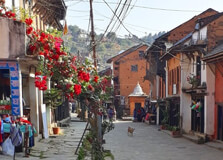
Bandipur Bazaar, located in the scenic hills of central Nepal, is a traditional Newar town that has preserved its unique cultural and architectural heritage. Situated at an altitude of 1,030 meters above sea level, Bandipur is known for its stunning mountain views, old-fashioned charm, and peaceful atmosphere. The town offers visitors a glimpse of rural Nepali life, with its narrow streets, historic temples, and beautiful pagoda-style buildings. The vibrant Bandipur Bazaar is the heart of the town and a major attraction for visitors. Its well-preserved architecture, surrounded by the natural beauty of the Himalayas, makes it an ideal place for tourists looking for tranquility, culture, and a touch of history. It’s a great stop for those traveling from Pokhara to Kathmandu or vice versa. How to Reach Bandipur Bazaar, Bandipur Bandipur is located about 8 kilometers from the Prithvi Highway, which connects Kathmandu and Pokhara. The town is easily accessible by road and is a popular stopover for tourists traveling between these two cities. By Air: The nearest airport to Bandipur is in Pokhara, which is around 70 kilometers away. From Pokhara, you can take a local bus or hire a private vehicle to reach Bandipur. It takes about 2 hours by road from Pokhara to Bandipur. By Road: If you're traveling from Kathmandu, you can take a tourist bus or a private vehicle to the Dumre junction, which is around 120 kilometers from Kathmandu. From Dumre, it’s a 30-minute drive to Bandipur. You can also take a local bus from Kathmandu to Dumre and then switch to another vehicle to reach Bandipur. By Private Vehicle: If you prefer more comfort and flexibility, hiring a private vehicle is a great option. The drive is scenic, and you can stop along the way for photos or refreshments. Weather of Bandipur Bazaar, Bandipur The weather in Bandipur is typically mild throughout the year, with clear skies and fresh air. The town enjoys a subtropical highland climate, with warm summers and cool winters. Here’s what to expect during different seasons: Summer (March to June): Summer temperatures in Bandipur range from 20°C to 30°C, making it a pleasant escape from the heat of the lowlands. This is a great time to visit if you prefer moderate temperatures. Monsoon (June to September): The monsoon season brings heavy rains to Bandipur. While the lush greenery during this time is beautiful, the rain can cause landslides and make traveling difficult. It’s advisable to avoid the monsoon months unless you're prepared for the wet conditions. Winter (October to February): Winter is the best time to visit Bandipur, with clear skies and cool temperatures ranging from 5°C to 15°C. It’s a great time for trekking and outdoor activities, and you can enjoy stunning views of the snow-capped mountains. Timing to Visit Bandipur Bazaar, Bandipur The best time to visit Bandipur is during the autumn (October to December) and spring (March to May) months when the weather is pleasant and the skies are clear. These seasons are ideal for sightseeing, trekking, and enjoying the natural beauty of the area. However, if you want to avoid the crowds, you can visit during the off-season (January to March) when the weather is cooler, but there are fewer tourists. Avoid the monsoon season (June to September) as roads can be slippery and landslides are common. Why Famous for Bandipur Bazaar, Bandipur? Bandipur Bazaar is famous for its well-preserved traditional Newar culture and architecture. The town was once a major trading hub on the ancient trade route between India and Tibet, and its historical significance is still visible in the buildings, temples, and local customs. Today, it’s popular for its scenic beauty, offering panoramic views of the surrounding mountains, including the Annapurna range. Bandipur’s cultural richness, including its festivals, temples, and local cuisine, also makes it an attractive destination for tourists seeking a blend of nature, culture, and history. Entry and Visit Details about Bandipur Bazaar, Bandipur There are no entry fees to visit Bandipur itself, as it is a public town. However, if you wish to explore certain attractions, there may be small fees: Temples and Historical Sites: Some temples and historical sites may require a small donation or entrance fee for maintenance. The famous Bindhyabasini Temple, for example, is a popular site in Bandipur. Trekking and Hiking: There are several trekking routes around Bandipur, such as the hike to the Siddha Cave, which is one of the largest caves in Nepal. Entry to the cave may require a permit. ��Ӱֱ��stays and Lodging: If you plan to stay overnight, there are a variety of budget-friendly homestays, guesthouses, and small hotels where you can experience the local lifestyle. Prices generally range from NPR 500 to NPR 2,000 per night, depending on the type of accommodation. History and Architecture The history of Bandipur dates back to the 19th century when it was a thriving trading post on the trade route between India and Tibet. It was an important cultural and commercial hub before the development of modern transport systems shifted trade routes. The town is renowned for its preserved Newar architecture, characterized by intricate wood carvings, pagoda-style roofs, and temples. The traditional buildings and narrow streets give Bandipur a timeless charm, with a mixture of ancient and colonial influences. Key architectural highlights include the Bhanu Chowk (the central square), with its old Newar houses, and the Bindhyabasini Temple, which is dedicated to the goddess Bindhyabasini. The local temples are decorated with beautiful wood carvings, and the town retains an old-world charm that attracts both history buffs and photographers alike. Things to Do at Bandipur Bazaar, Bandipur Explore the Streets: Walking around Bandipur’s cobblestone streets is an experience in itself. Explore the local shops, traditional Newar houses, and open courtyards. You’ll encounter many opportunities to interact with the friendly locals. Visit Siddha Cave: One of the largest caves in Nepal, Siddha Cave offers a challenging yet rewarding trek. The cave is famous for its stalactites and stalagmites and provides a great view of the surrounding area. Bindhyabasini Temple: This temple is dedicated to the goddess Bindhyabasini and offers beautiful views of the surrounding mountains. The temple’s intricate wood carvings and peaceful ambiance make it a must-visit site. Trekking and Hiking: Bandipur is surrounded by beautiful hills and forests, offering several trekking and hiking routes. The views from the top are breathtaking, and you can enjoy the fresh mountain air and local wildlife. Local Cuisine: Don’t miss the chance to try some of Bandipur’s traditional Newar dishes, including "chatamari" (a kind of rice crepe), "yomari" (a steamed sweet dumpling), and "sel roti" (a traditional rice donut). Facts and Tips about Bandipur Bazaar, Bandipur Bandipur is one of the few towns in Nepal that has retained its traditional Newar culture and architecture. The town is not very commercialized, which means you’ll experience a quieter, more authentic Nepali village life. Bandipur is known for its stunning views of the Himalayas, including the Annapurna and Langtang ranges. It’s best to wear comfortable shoes for walking around the narrow, cobblestone streets. Be sure to try the local delicacies and interact with the friendly locals to get a real sense of the culture.
Explore More